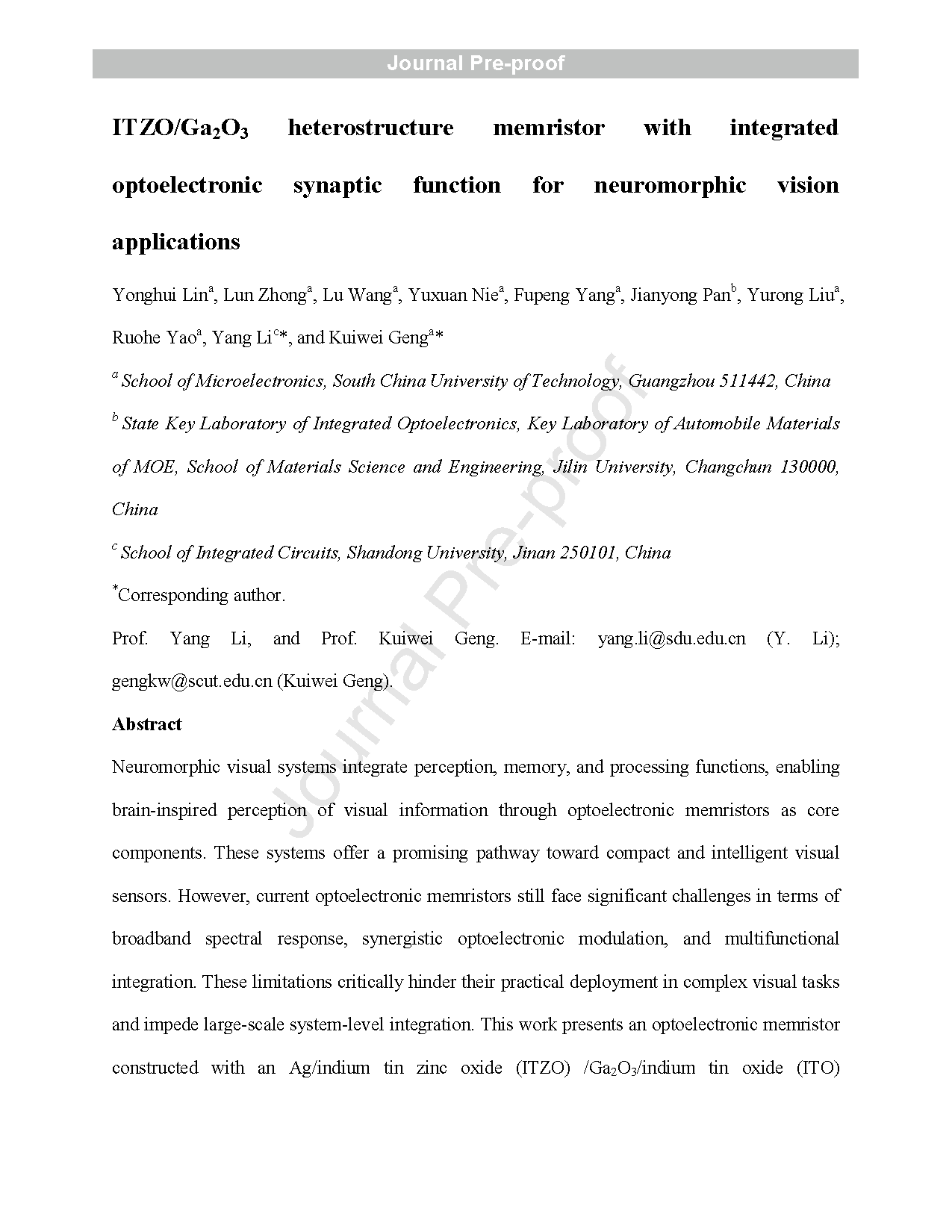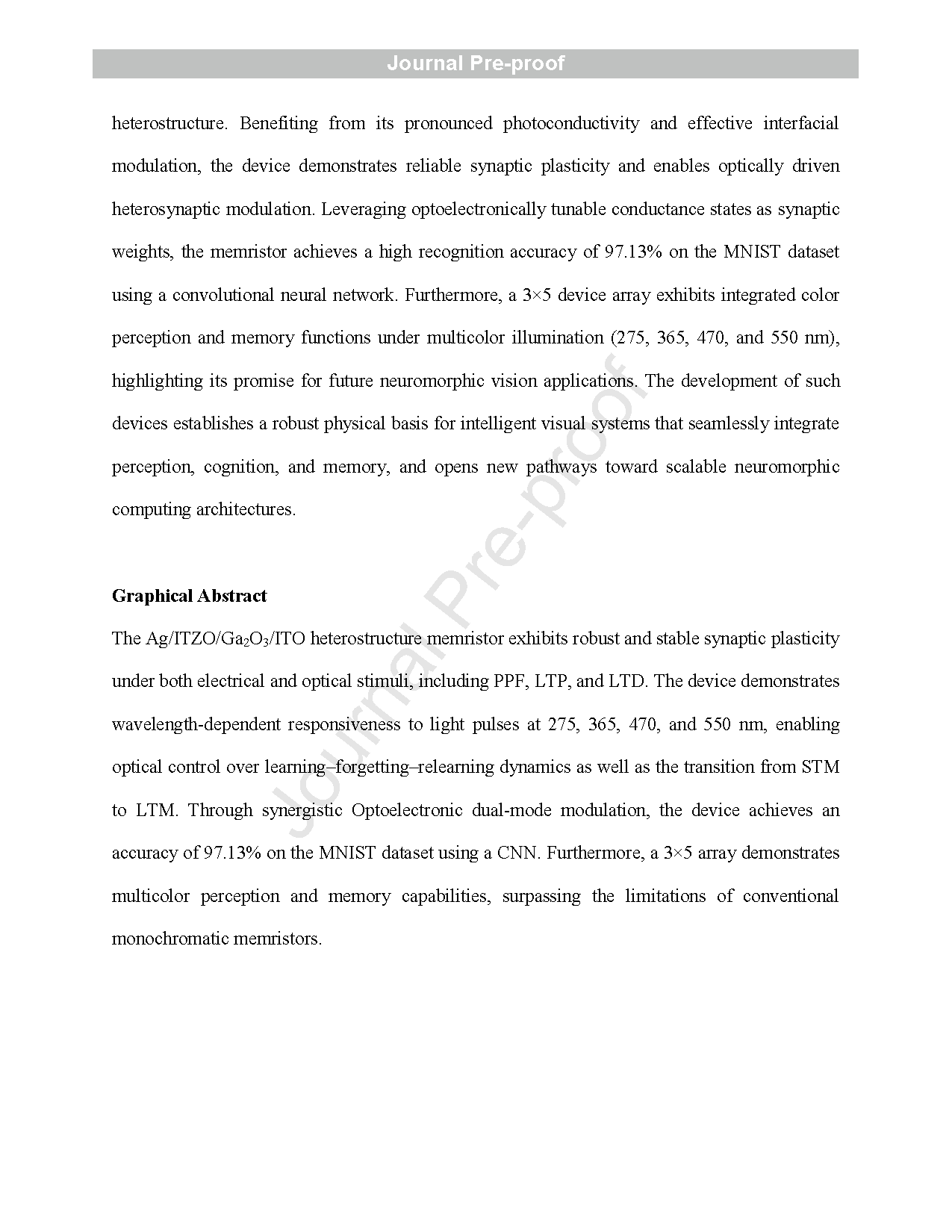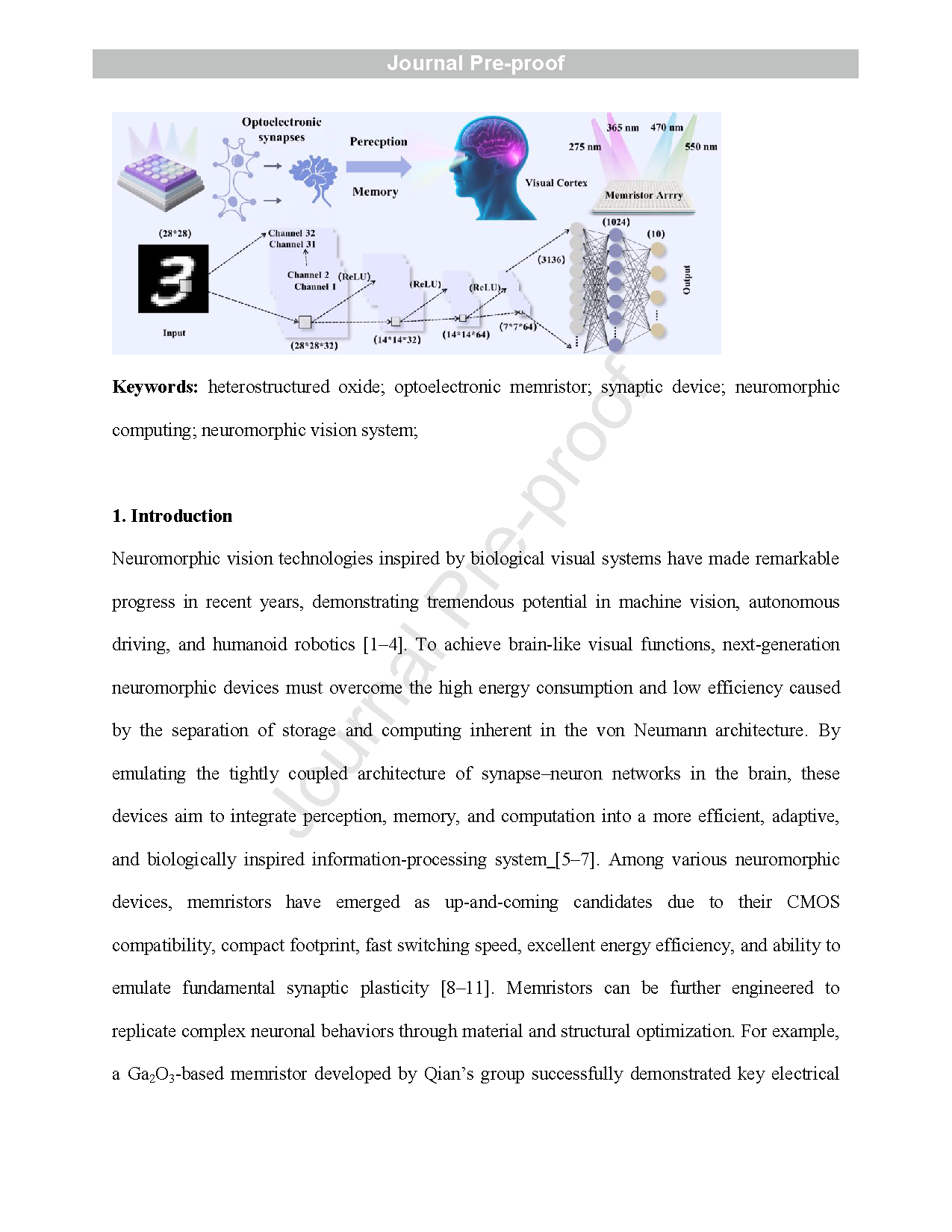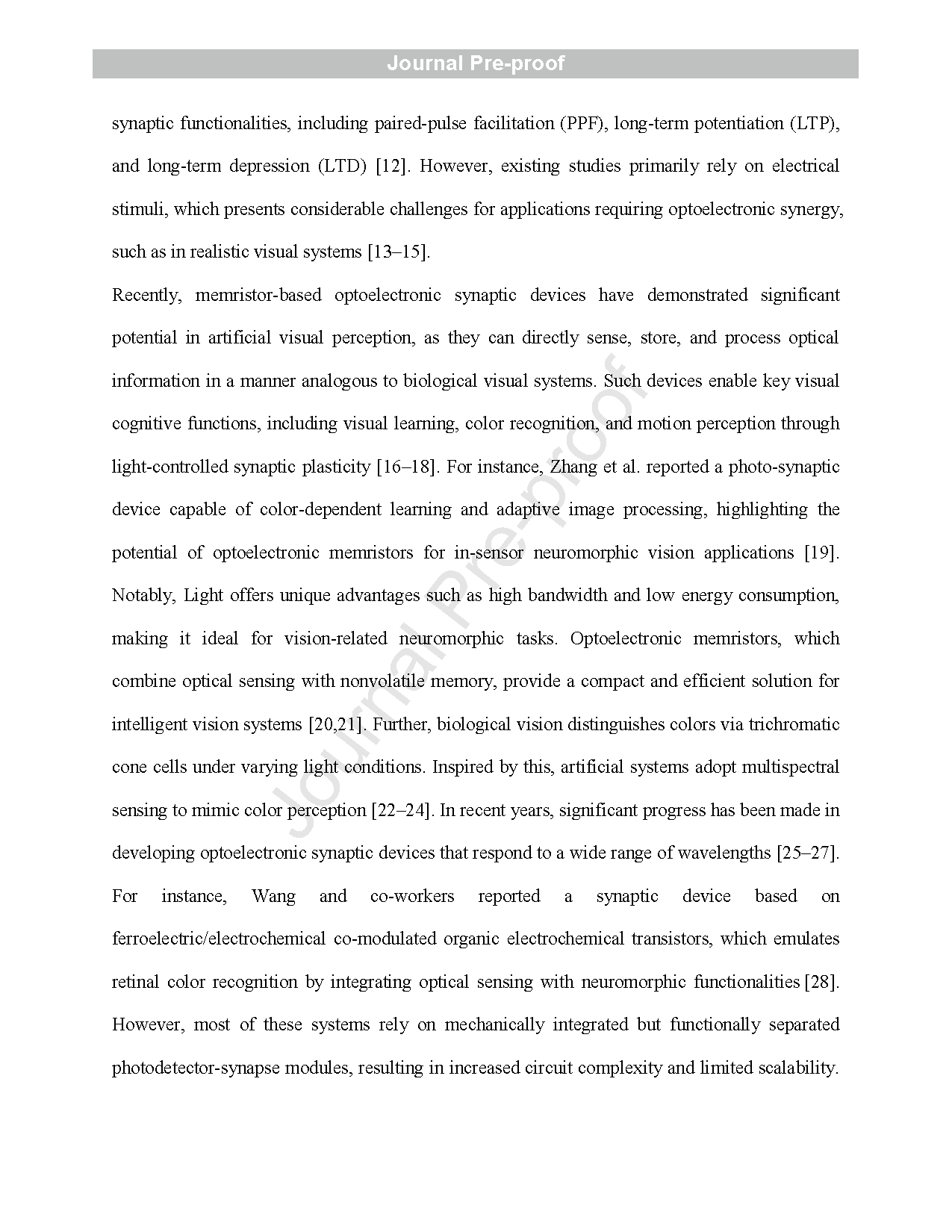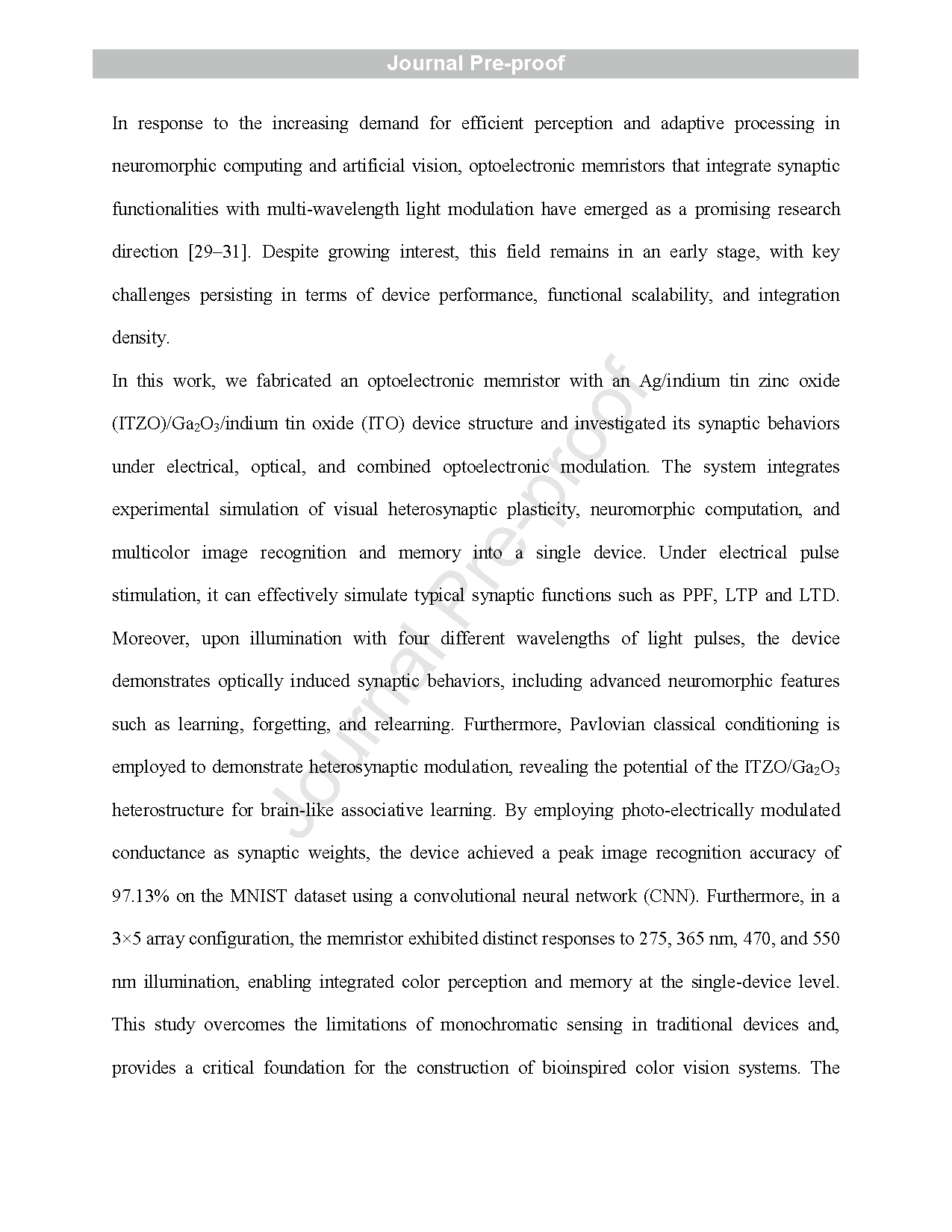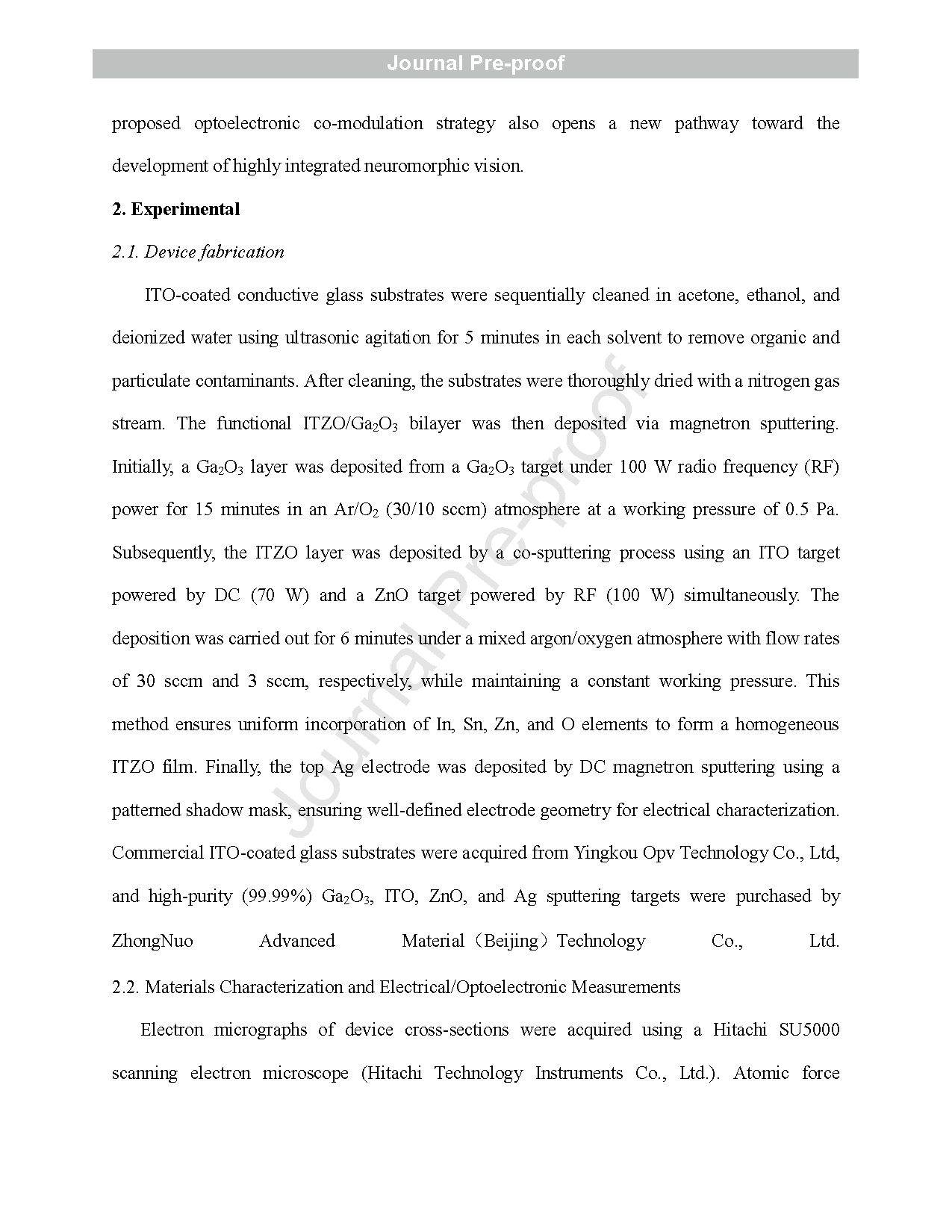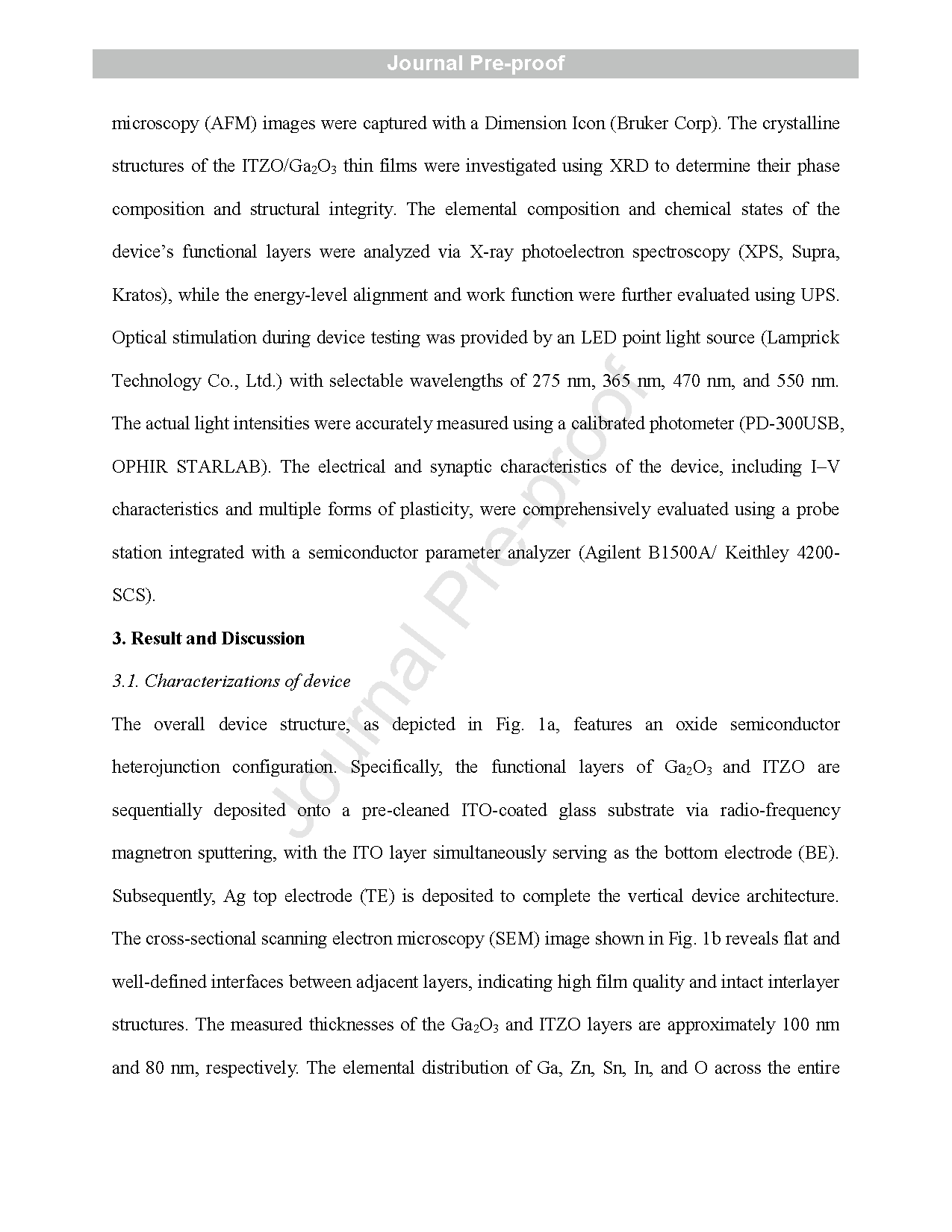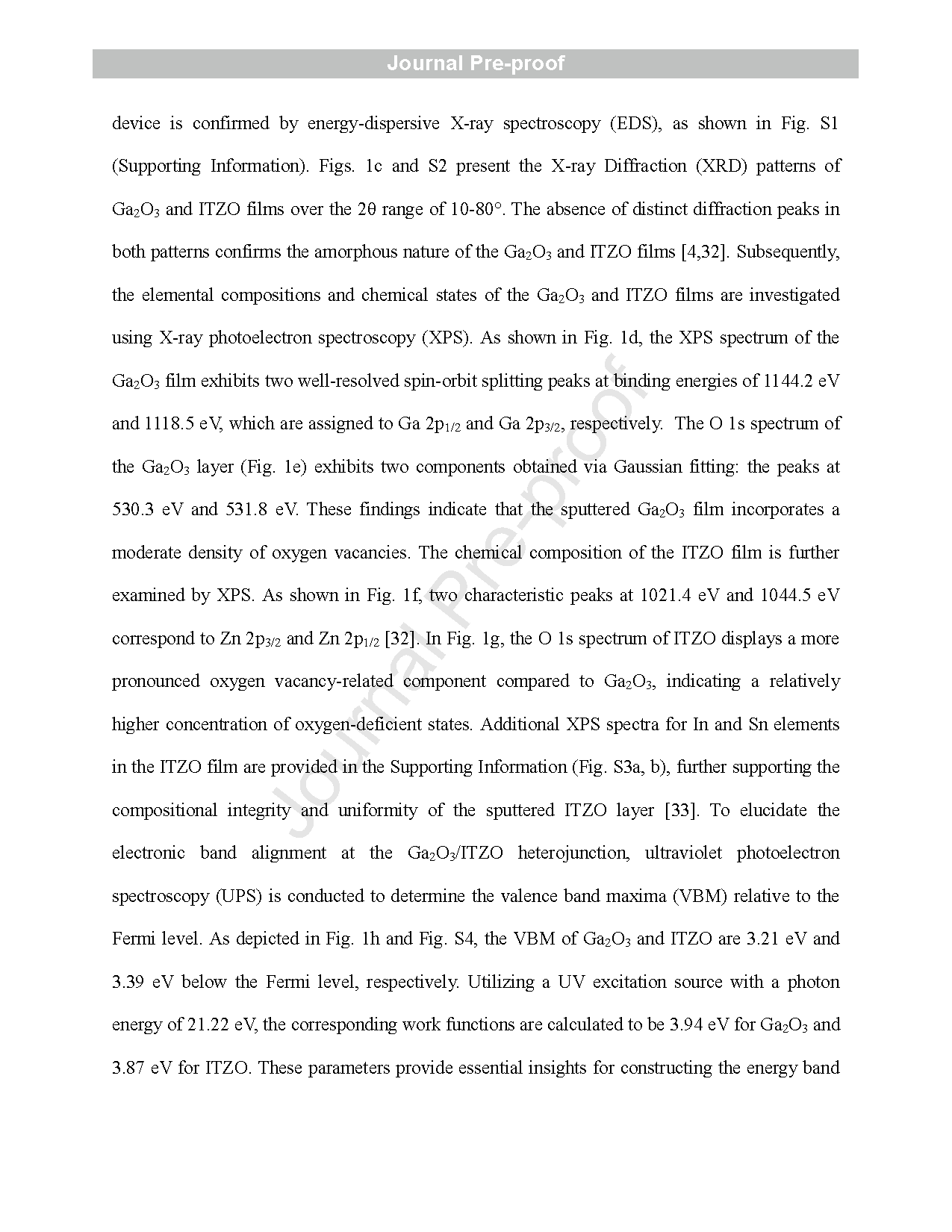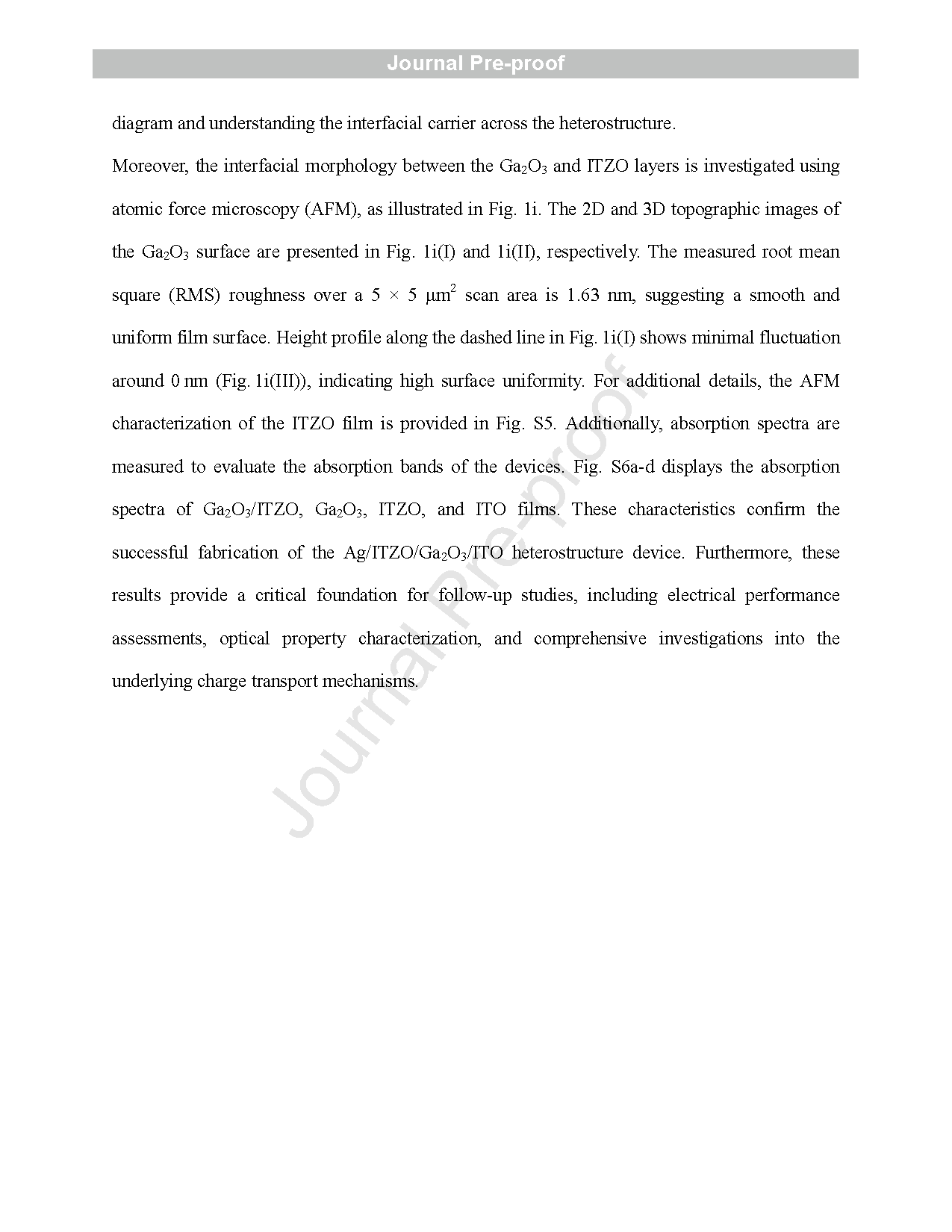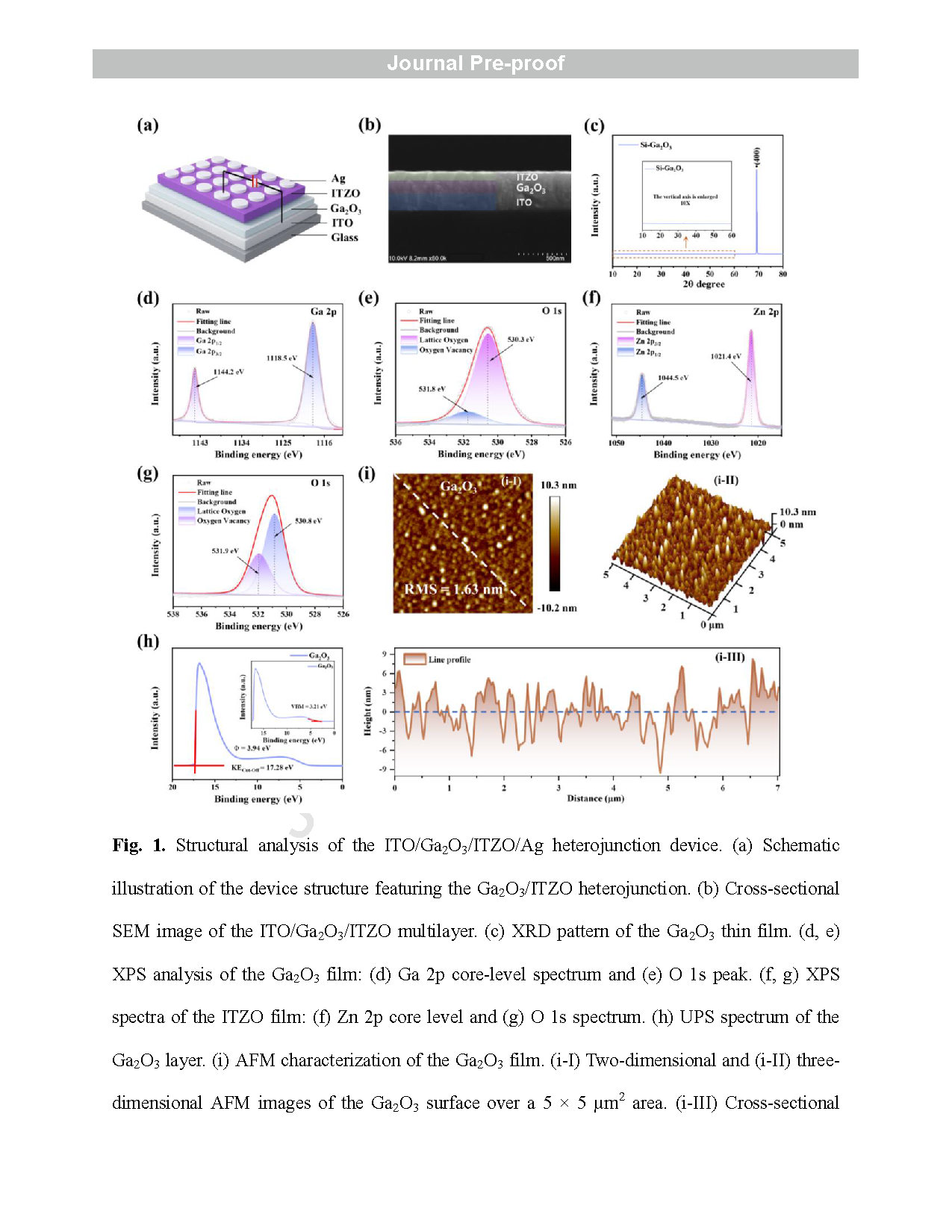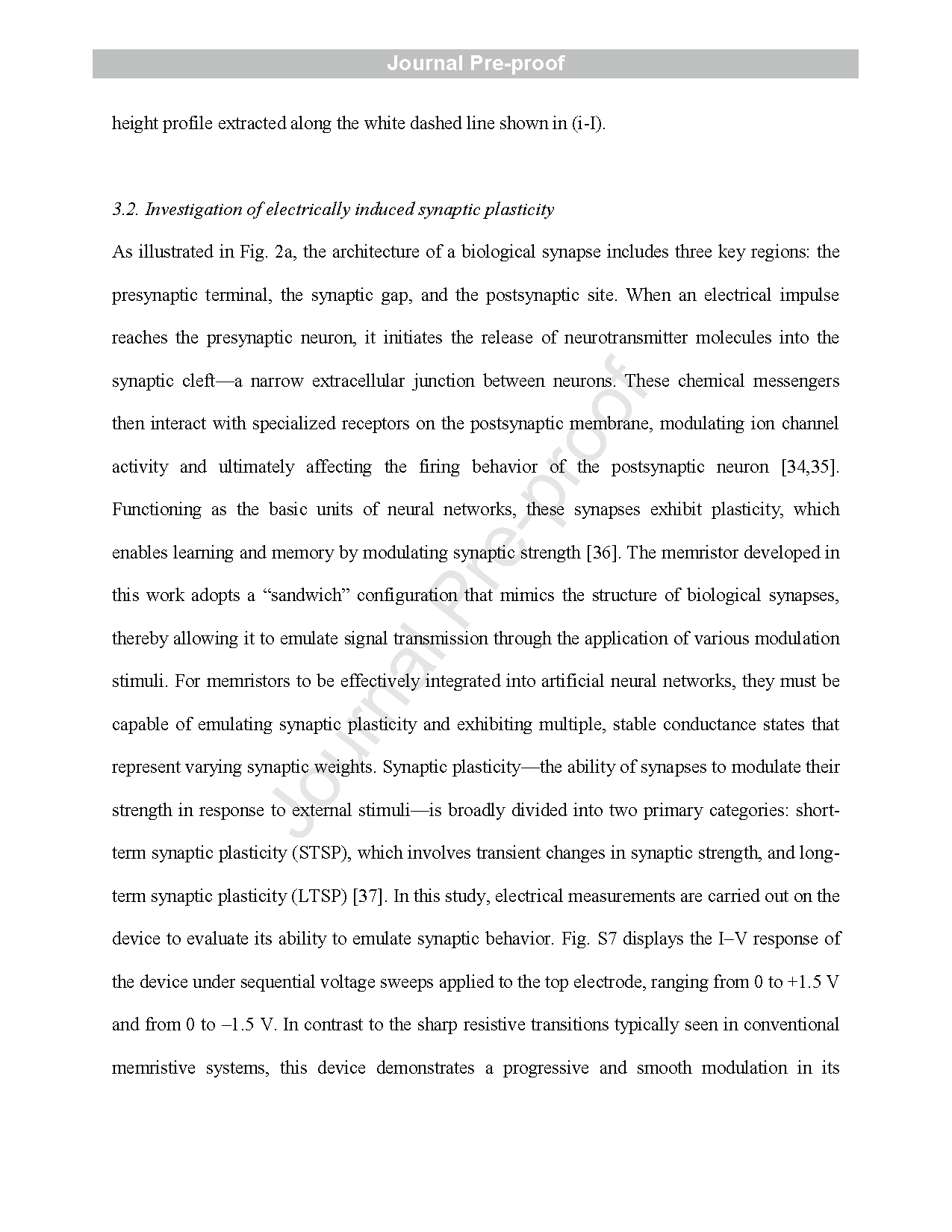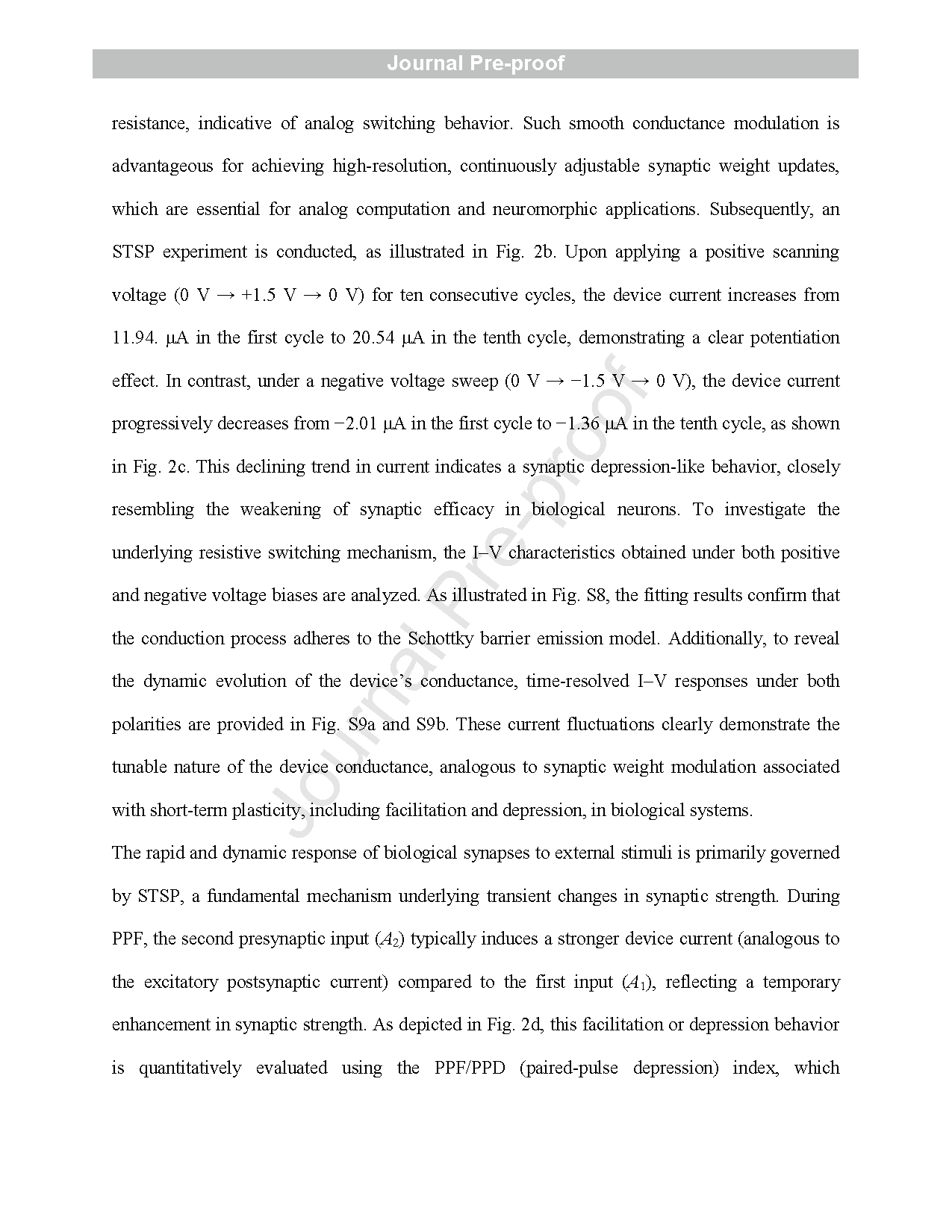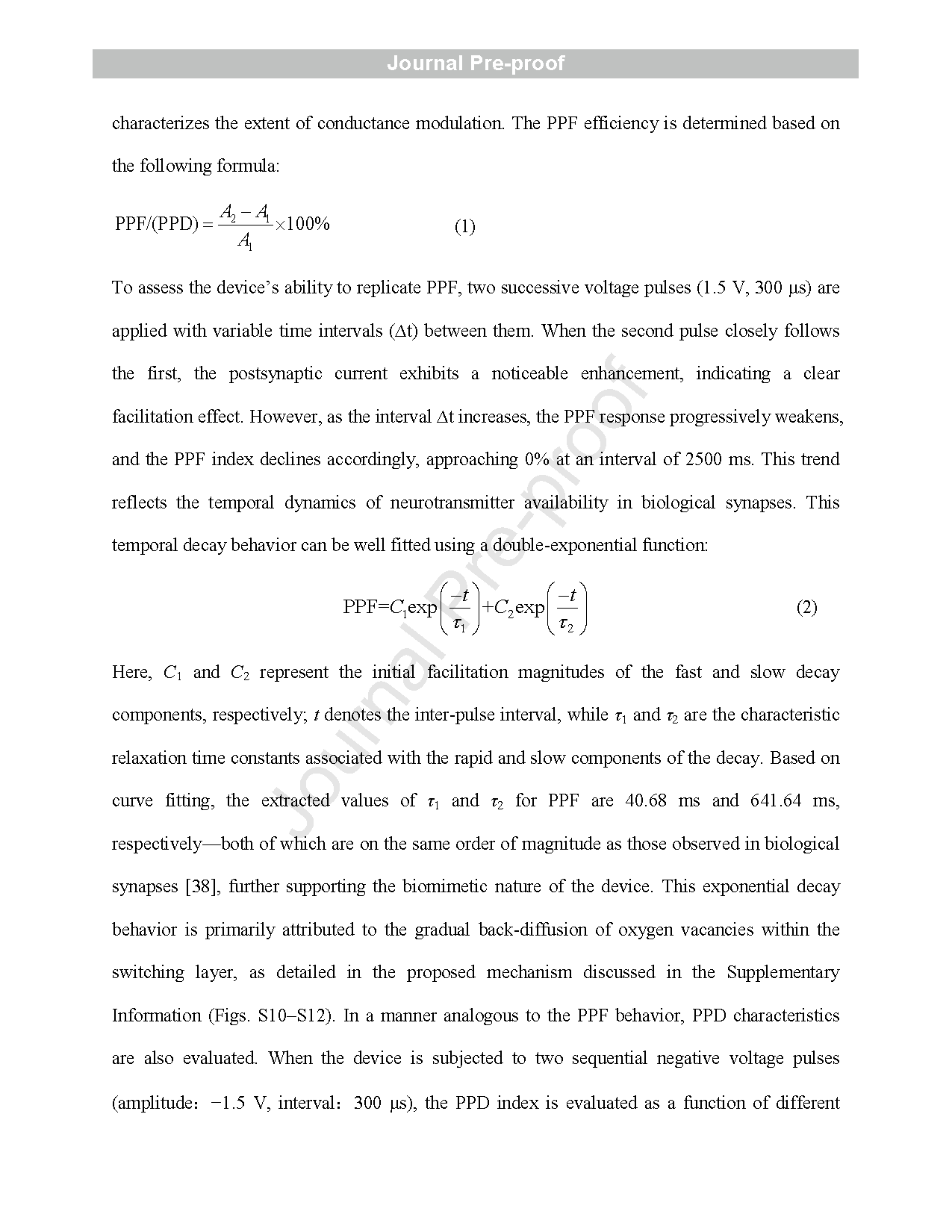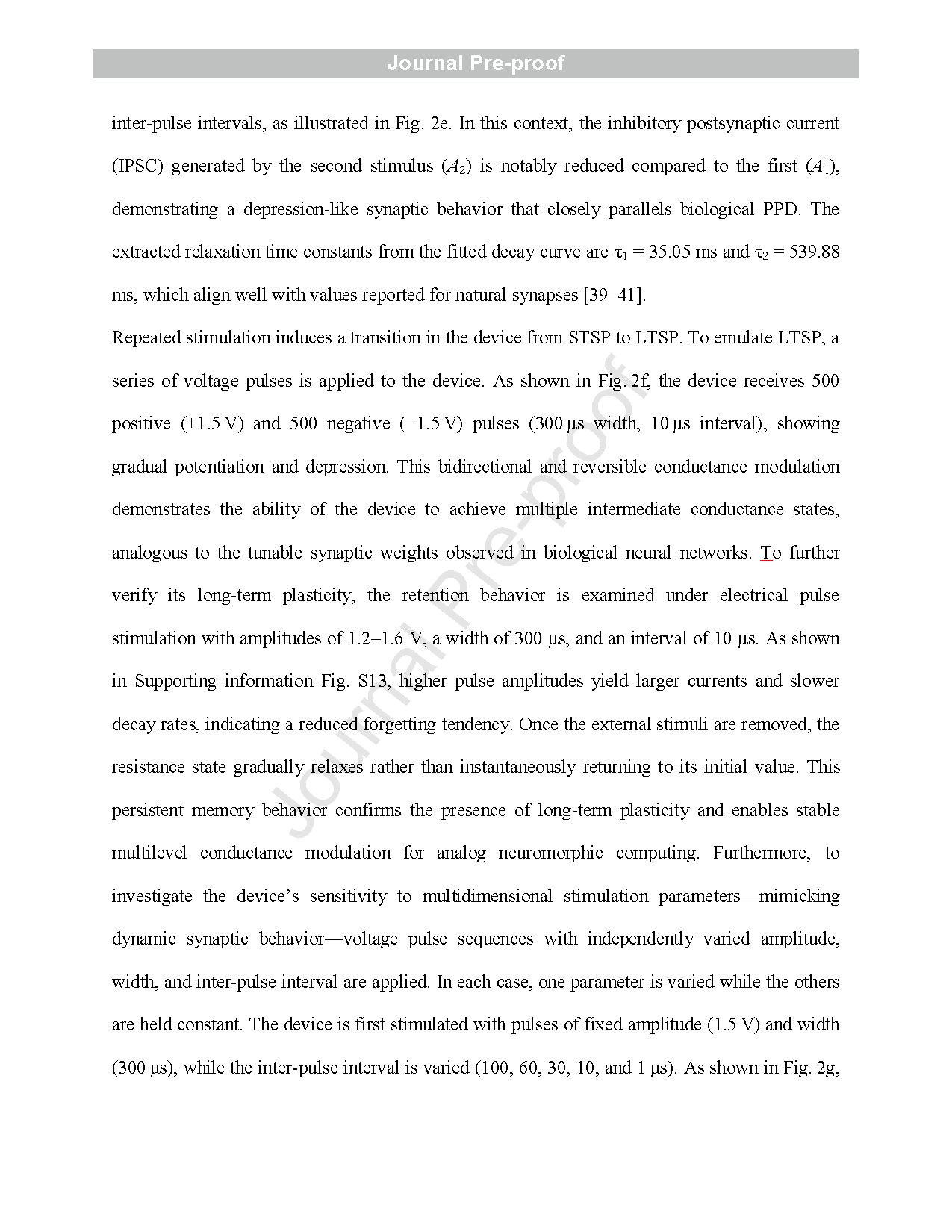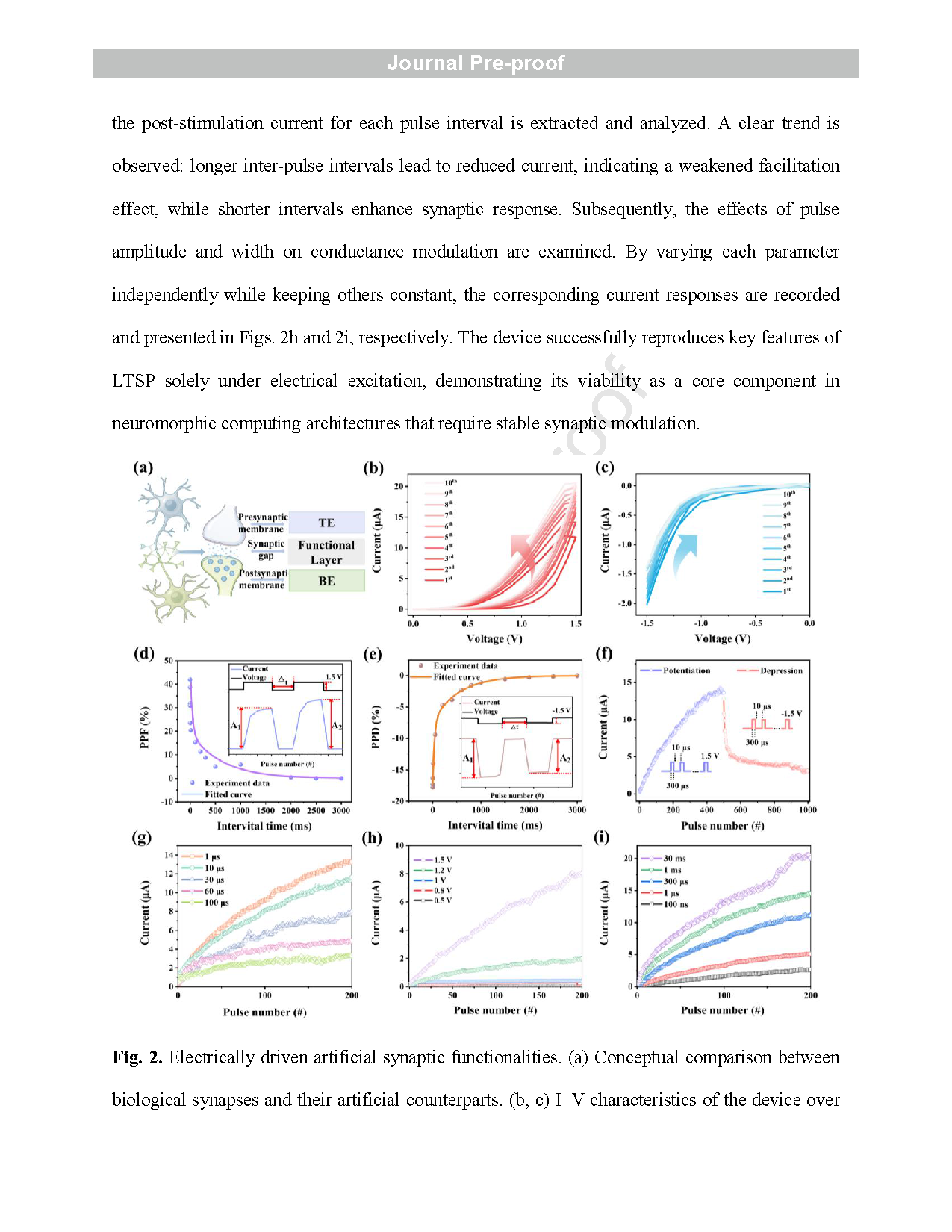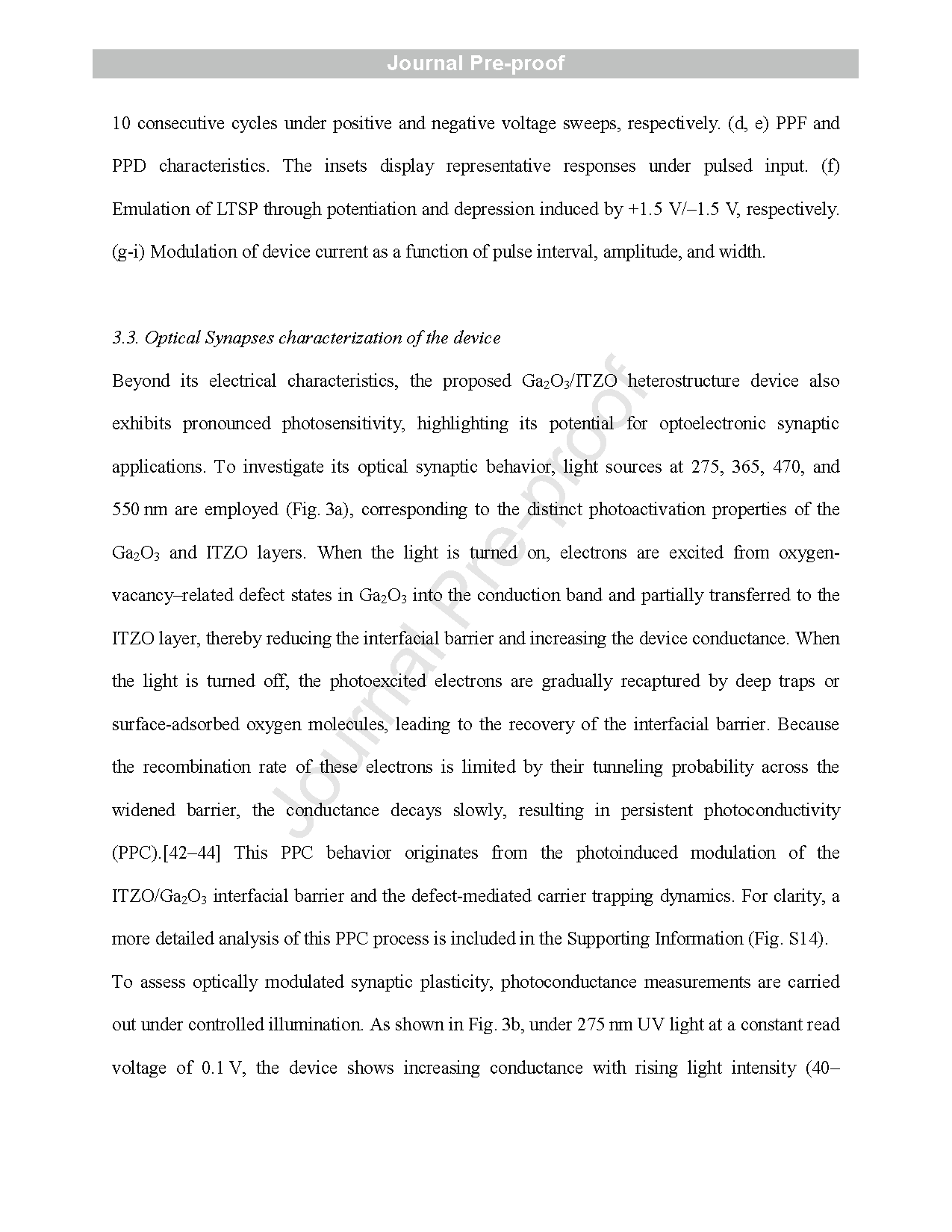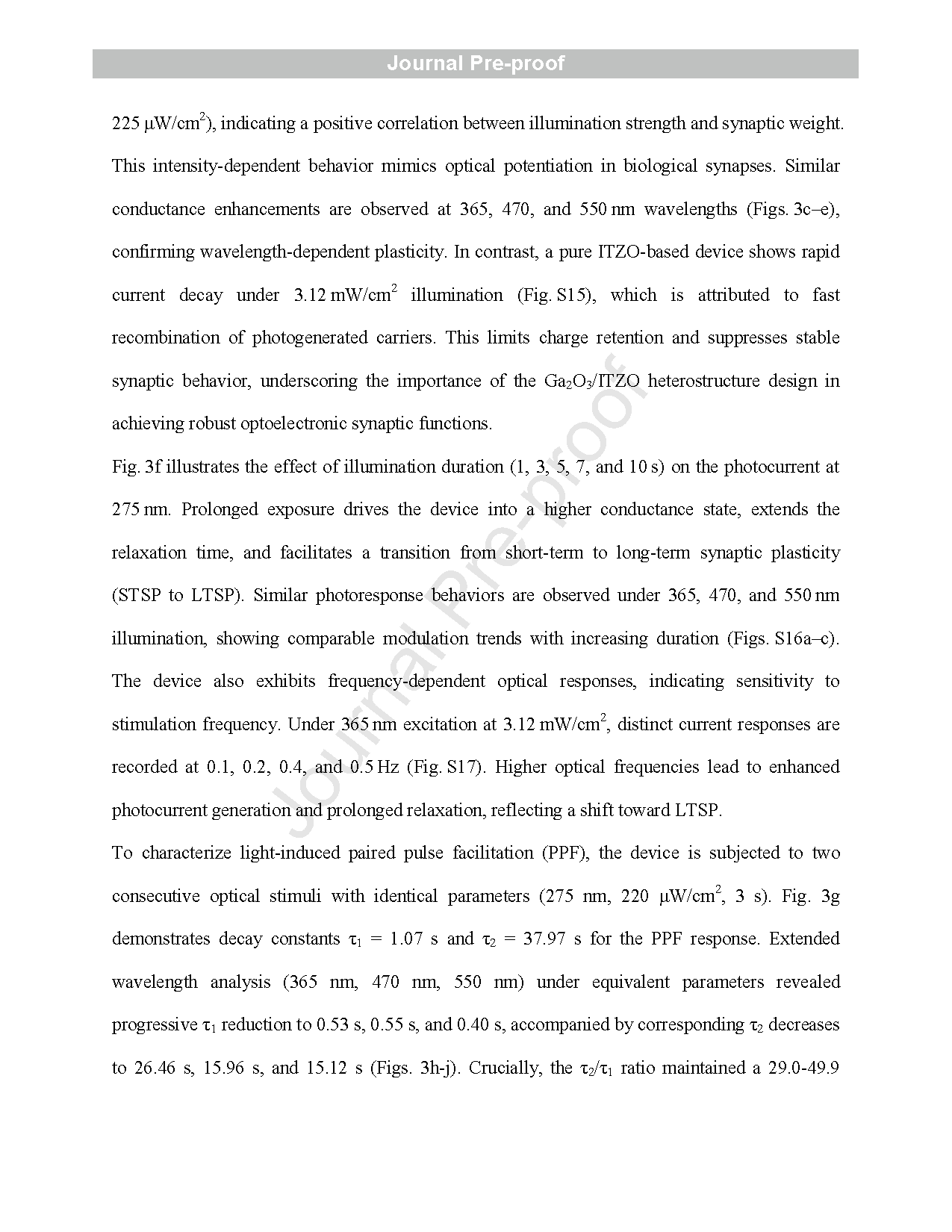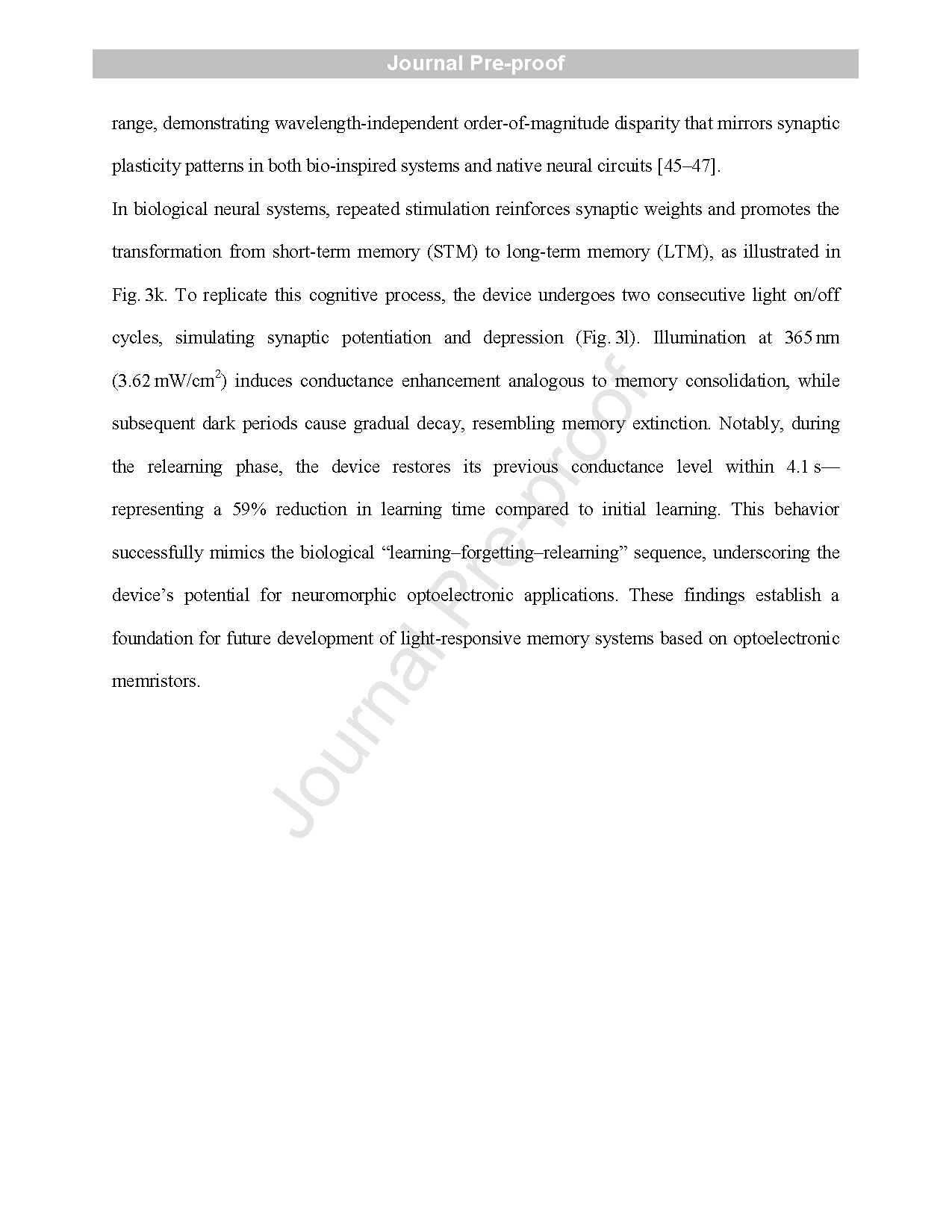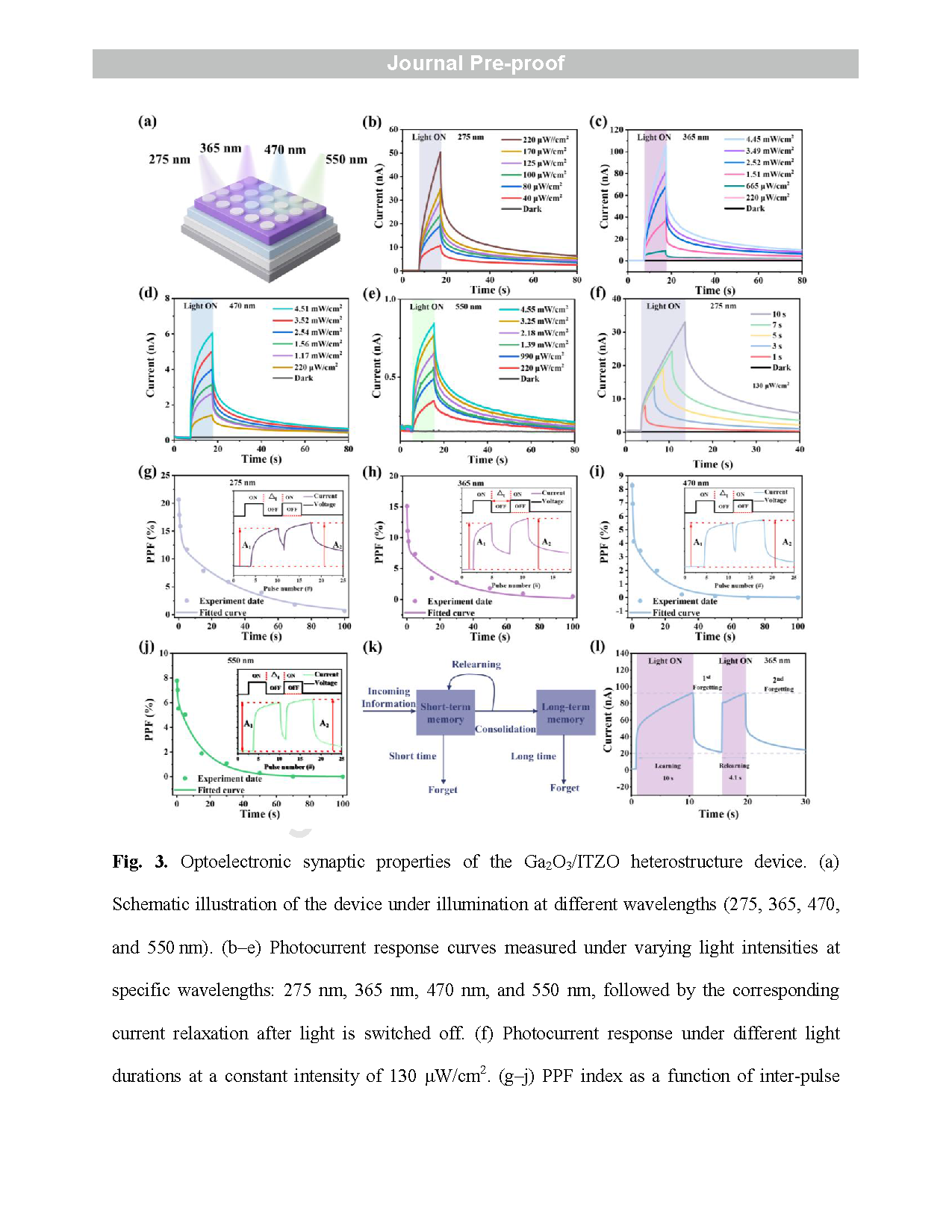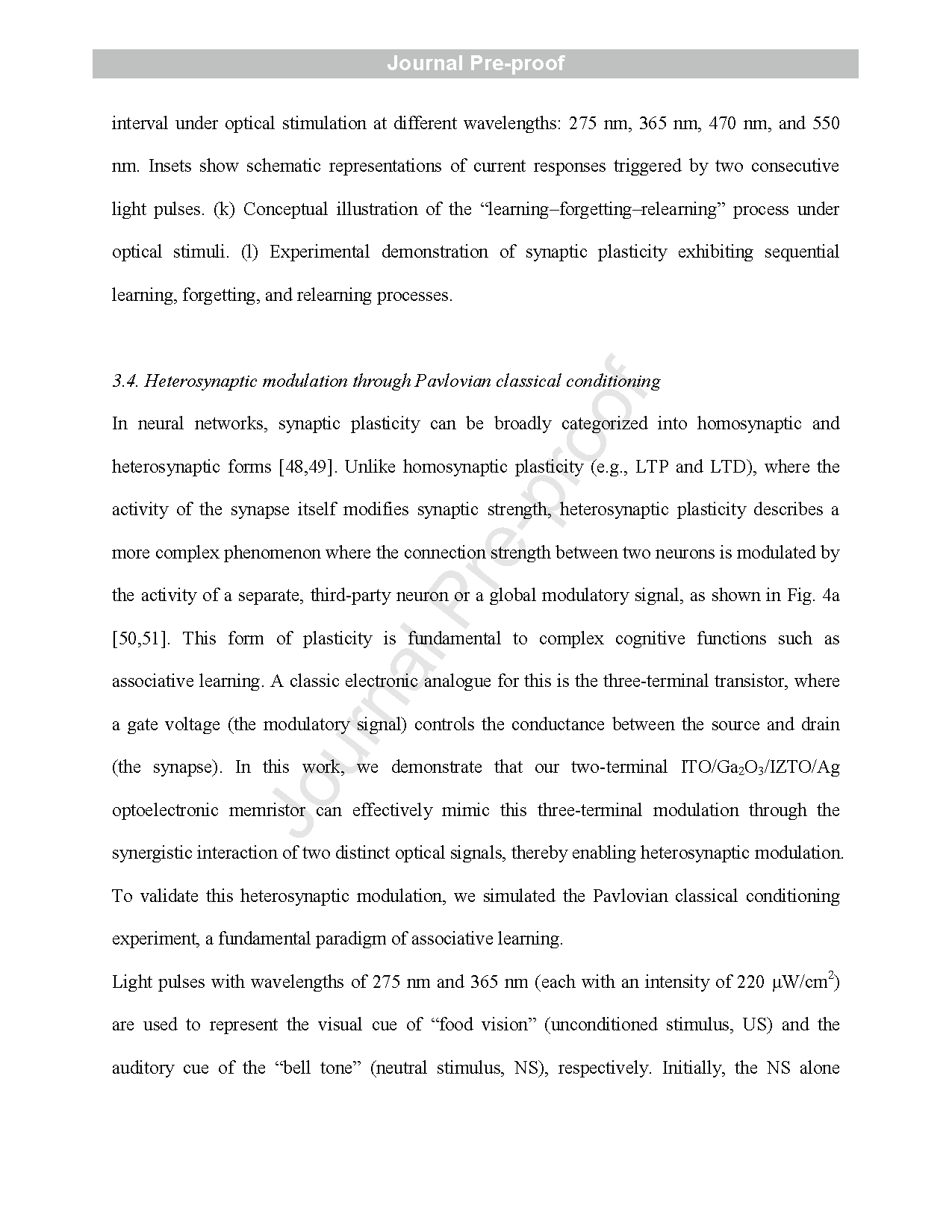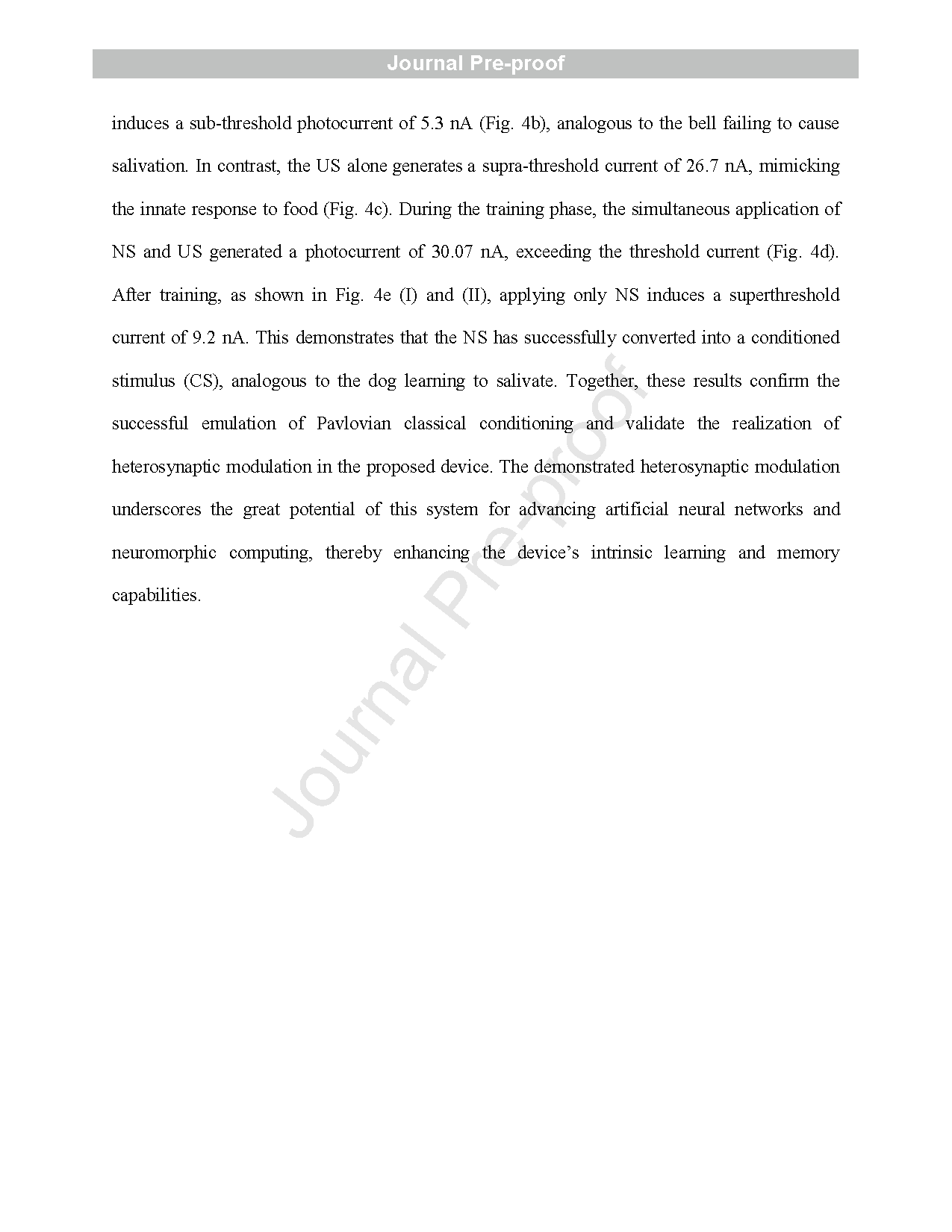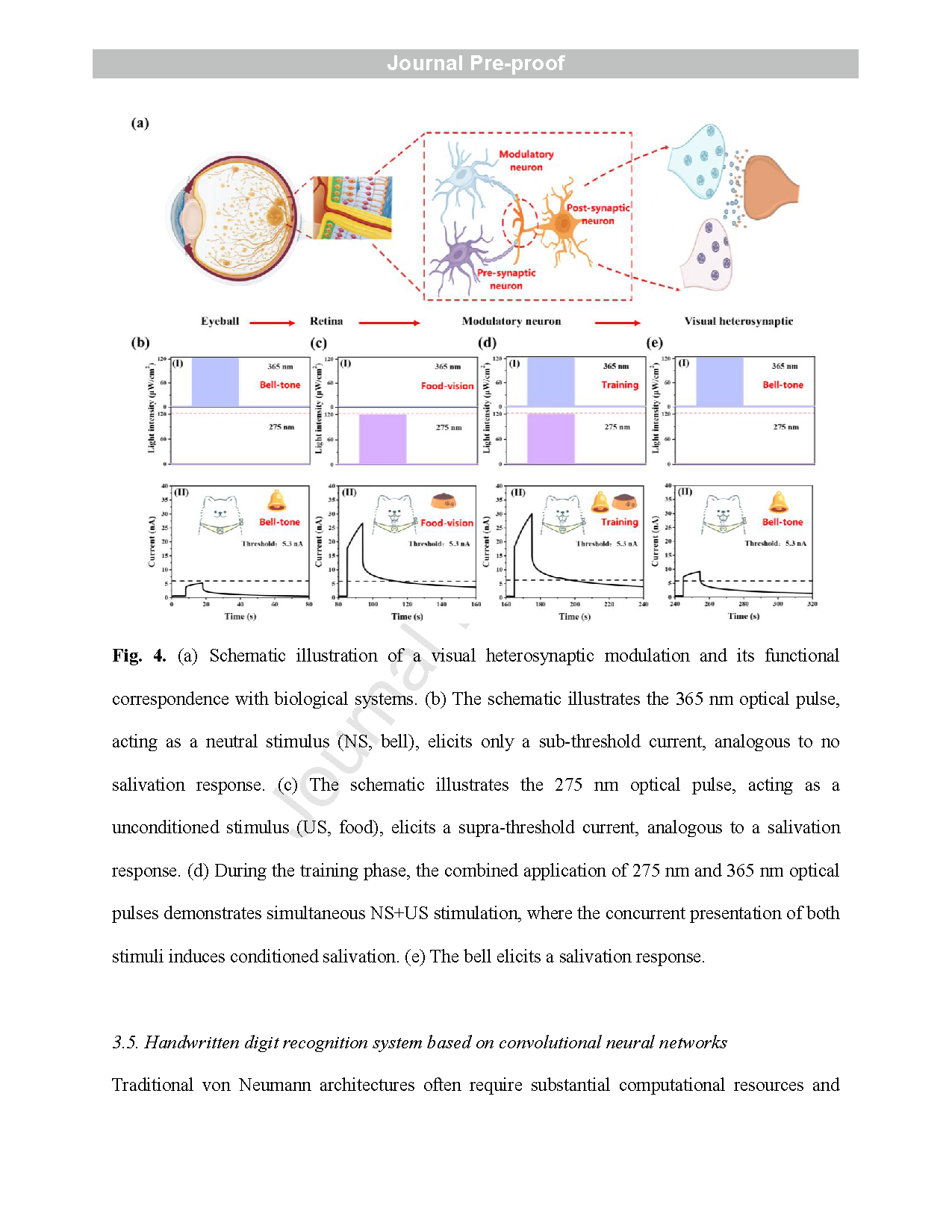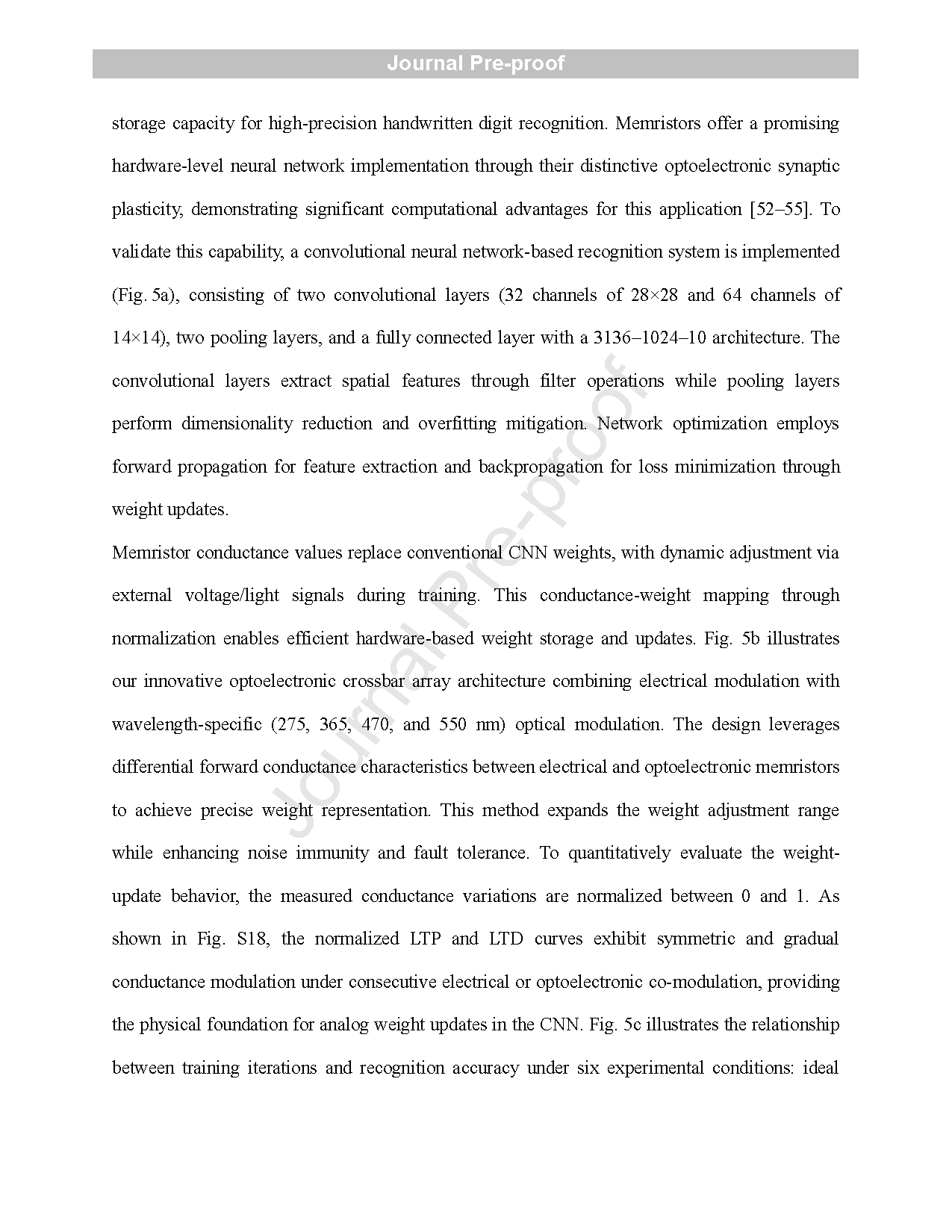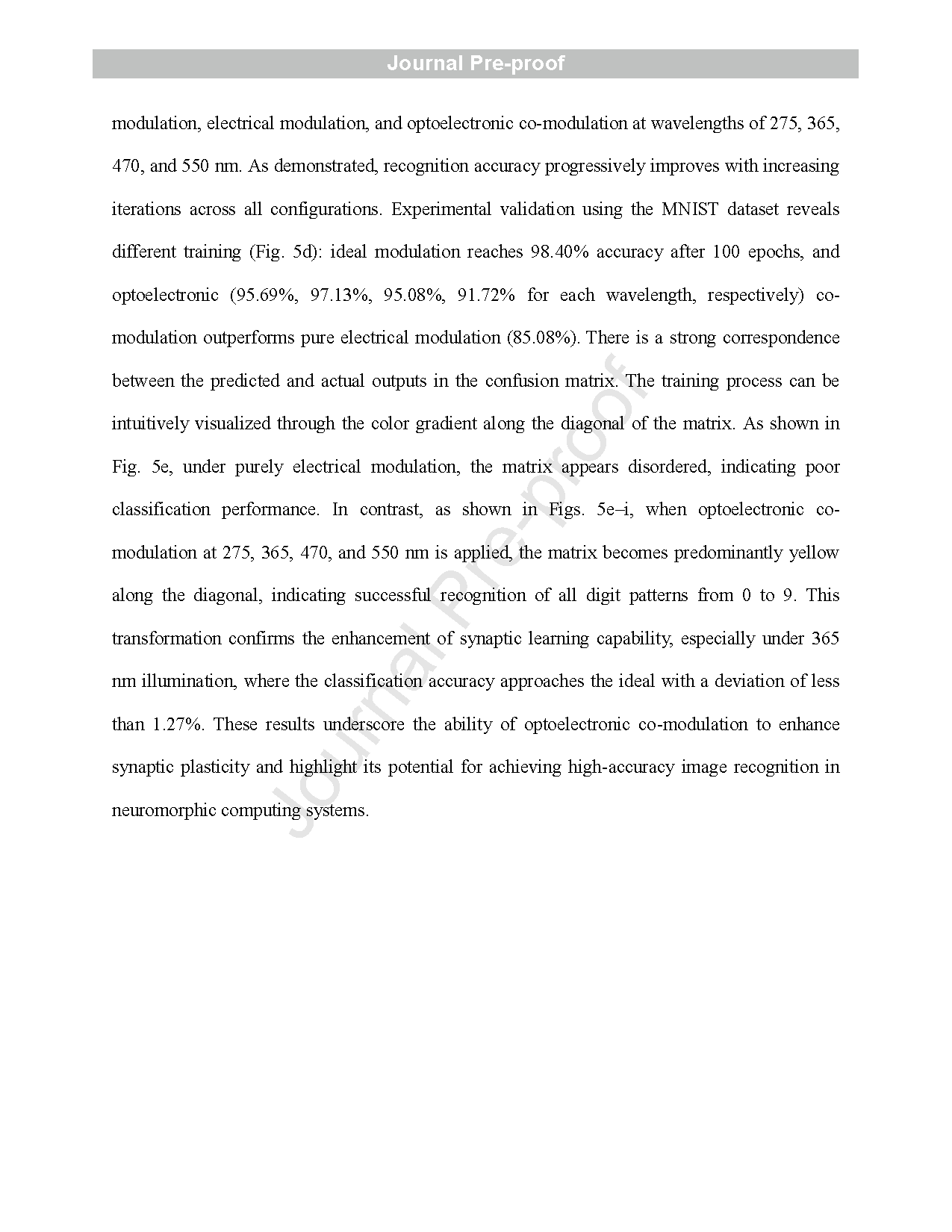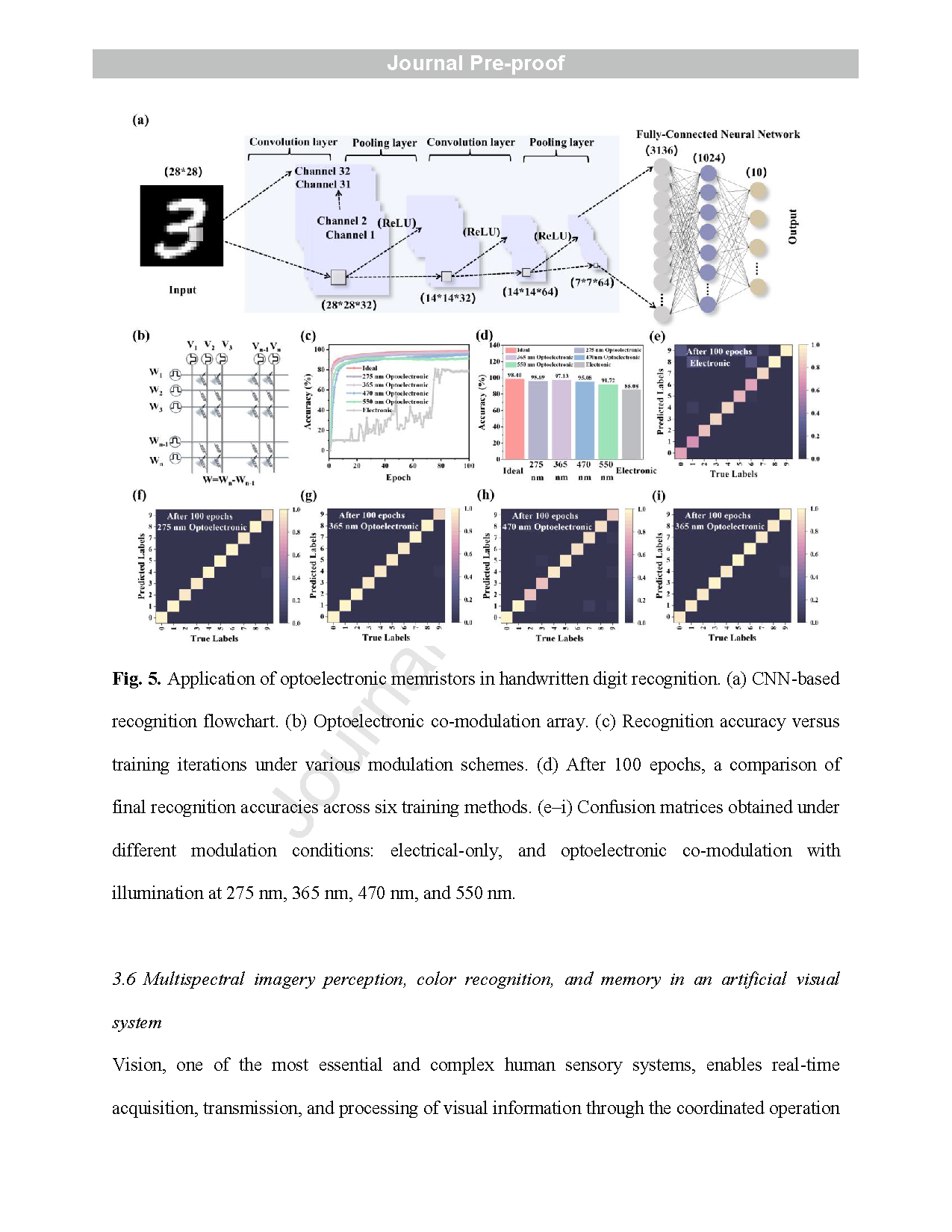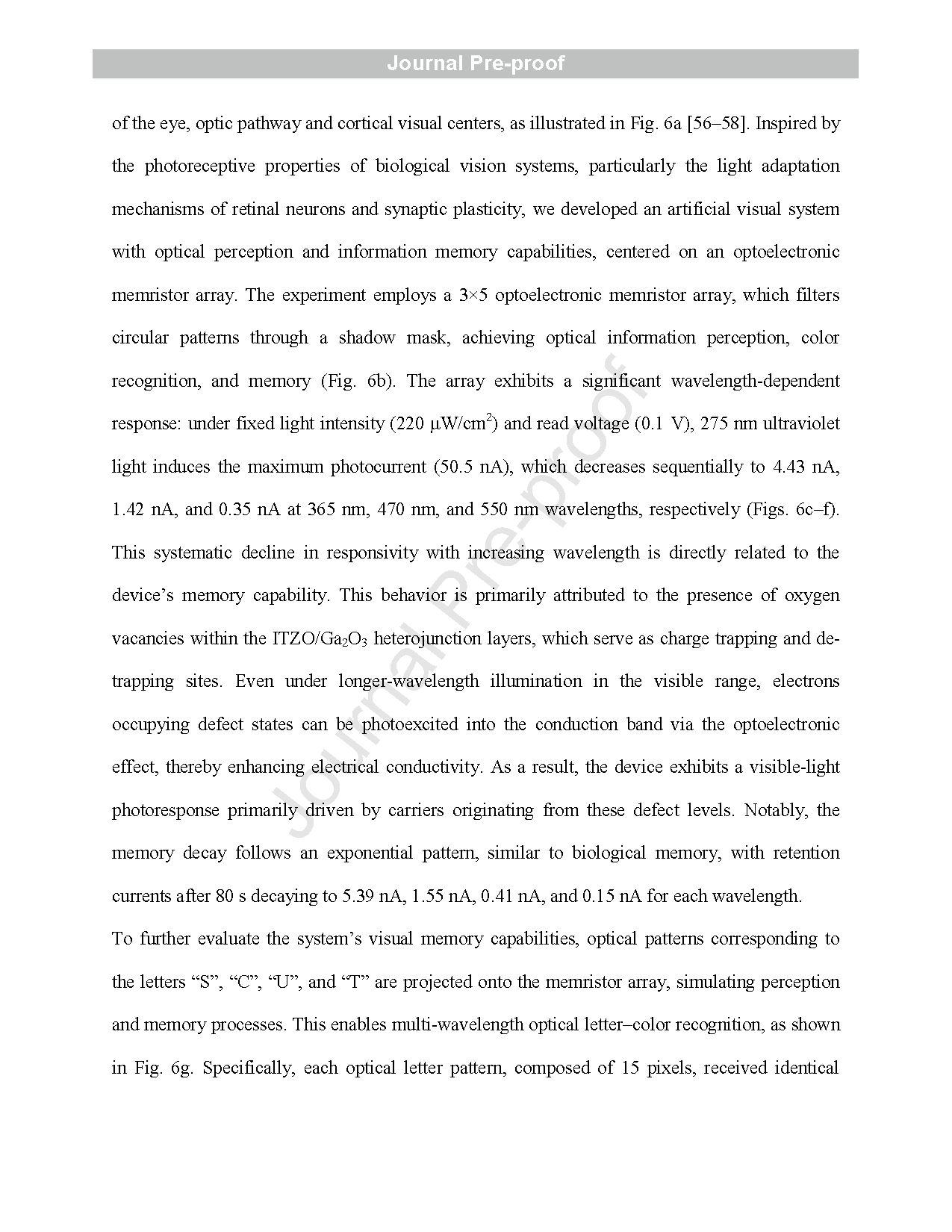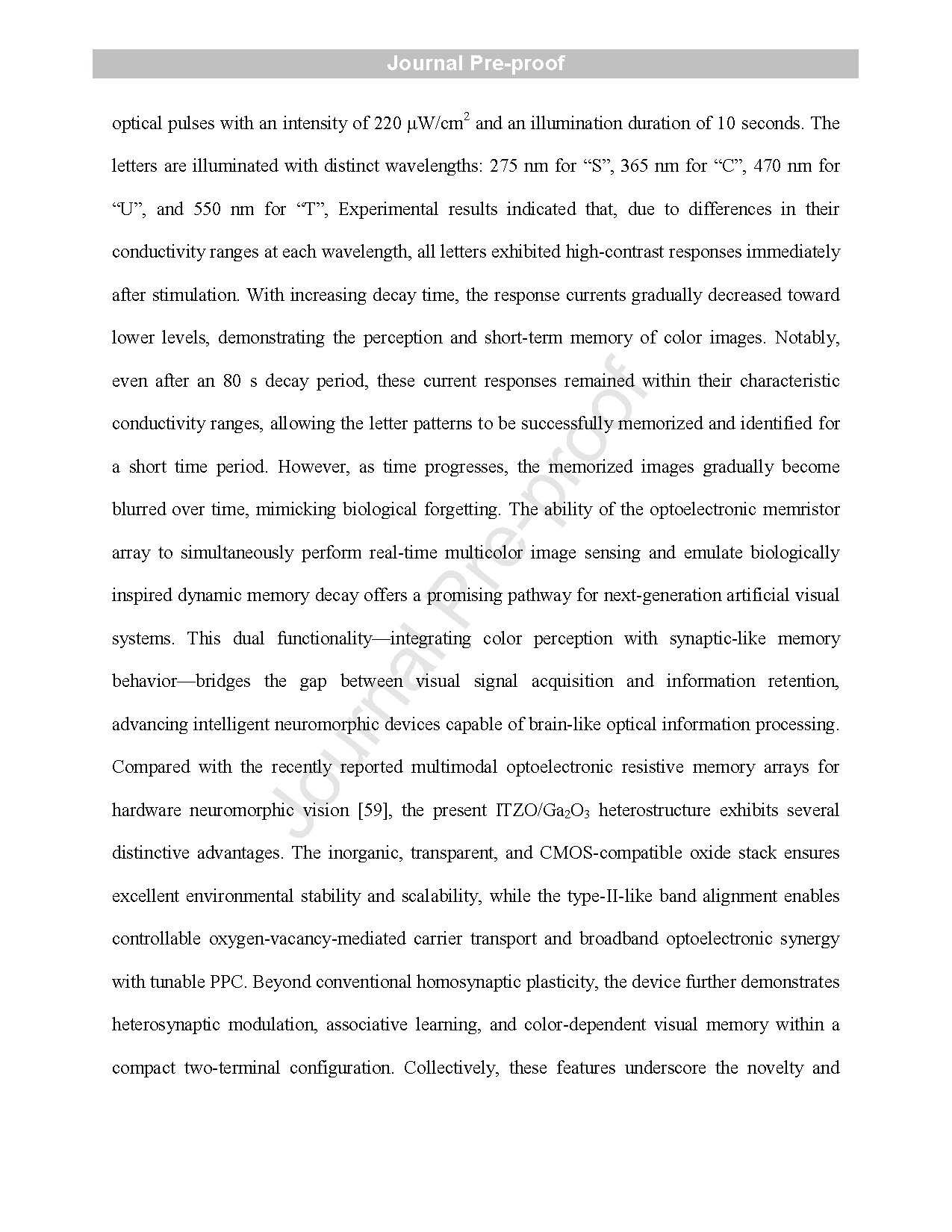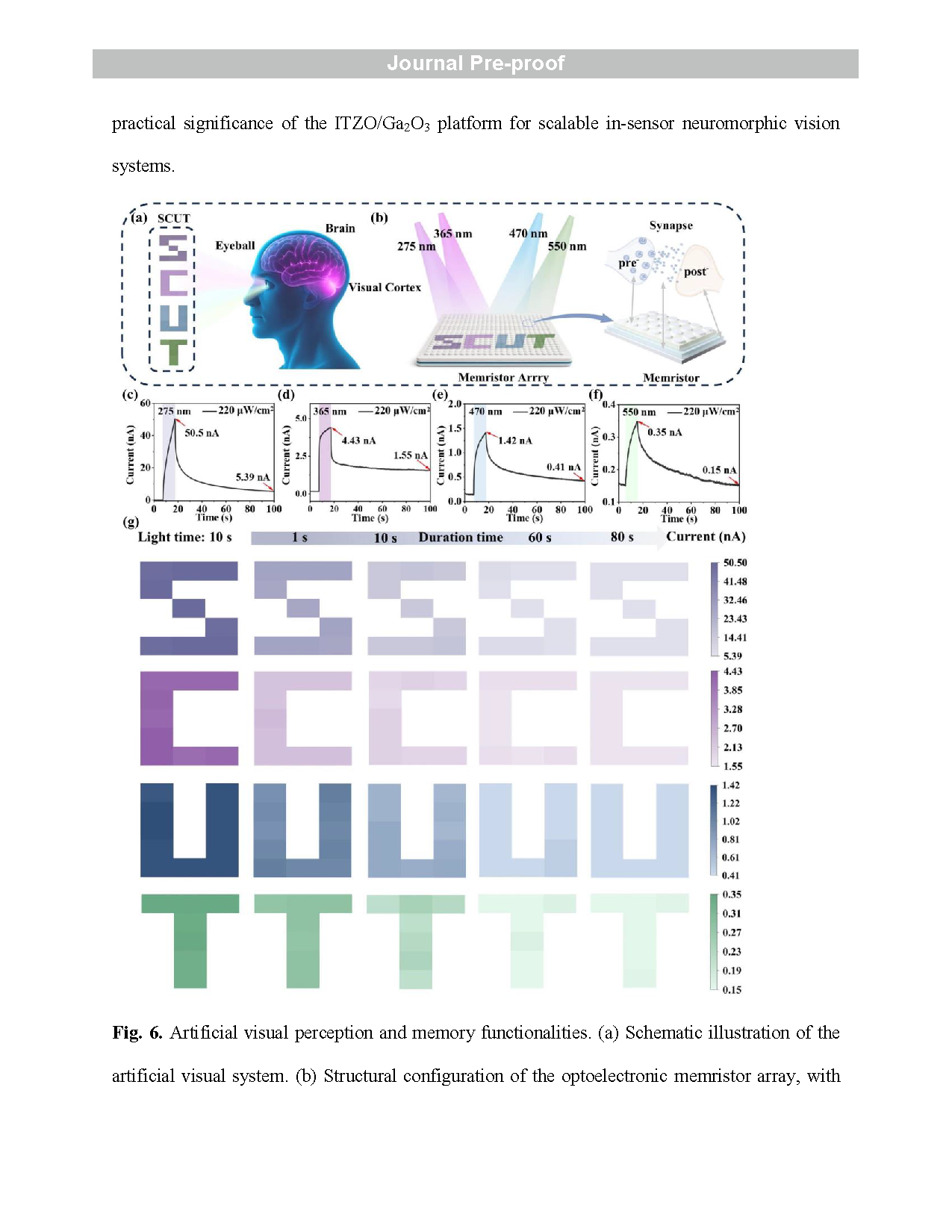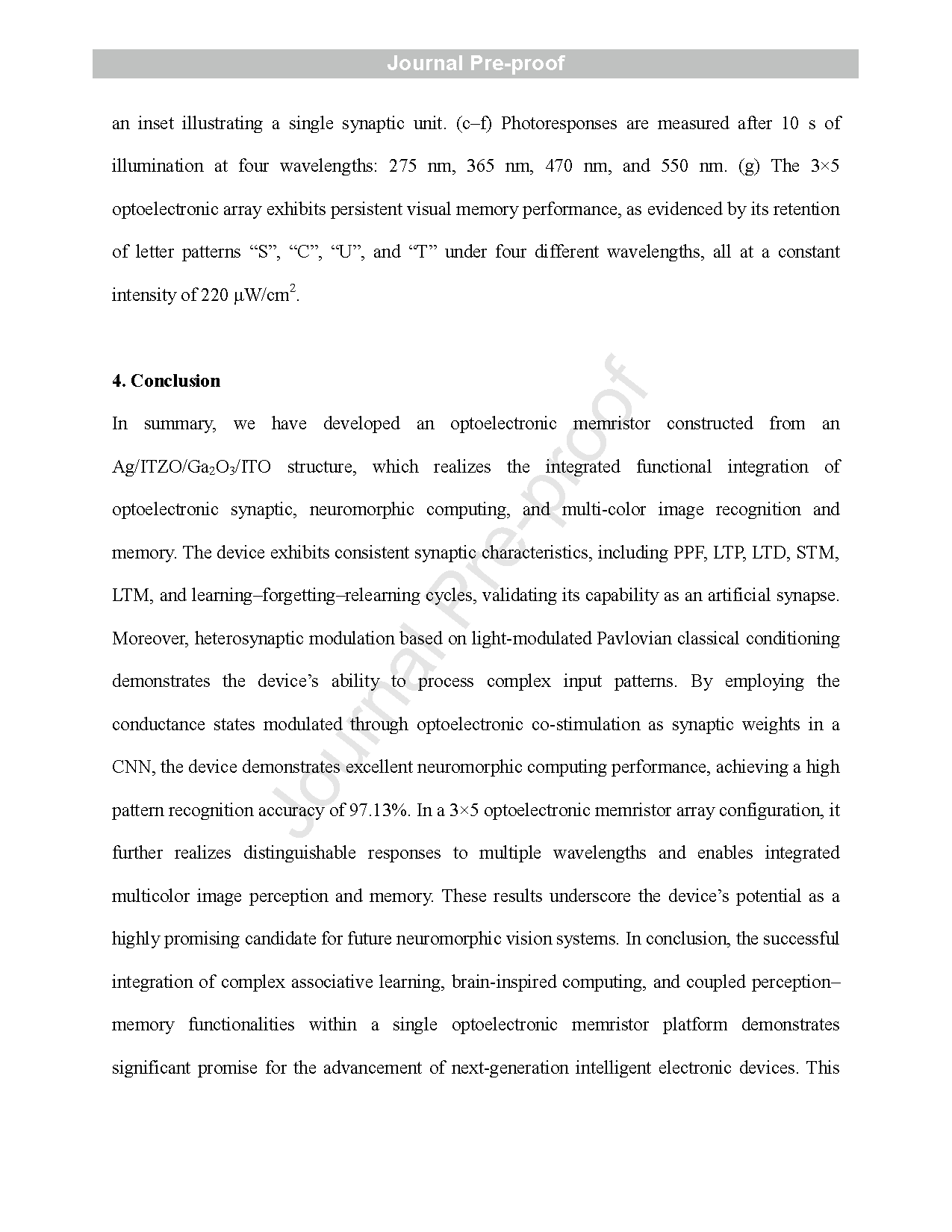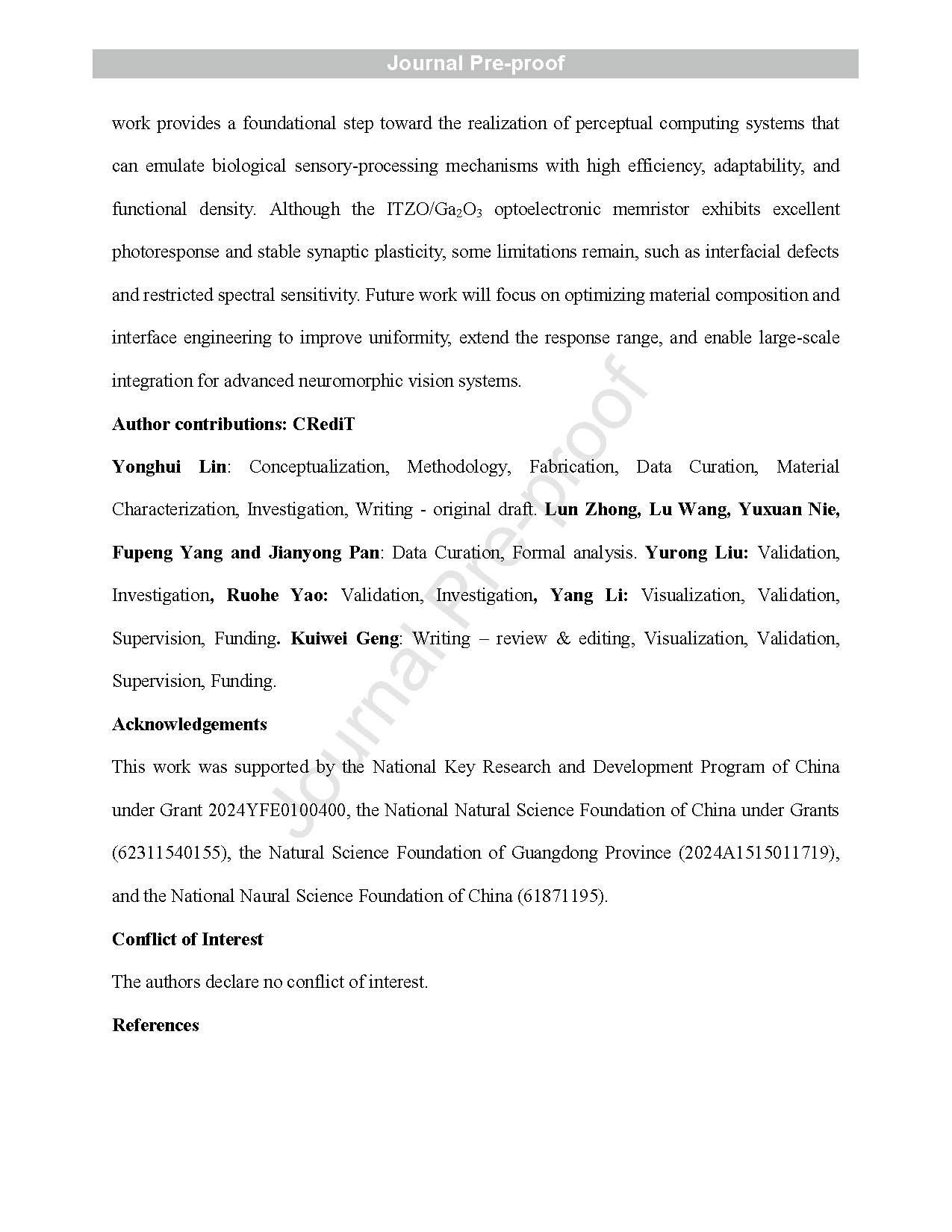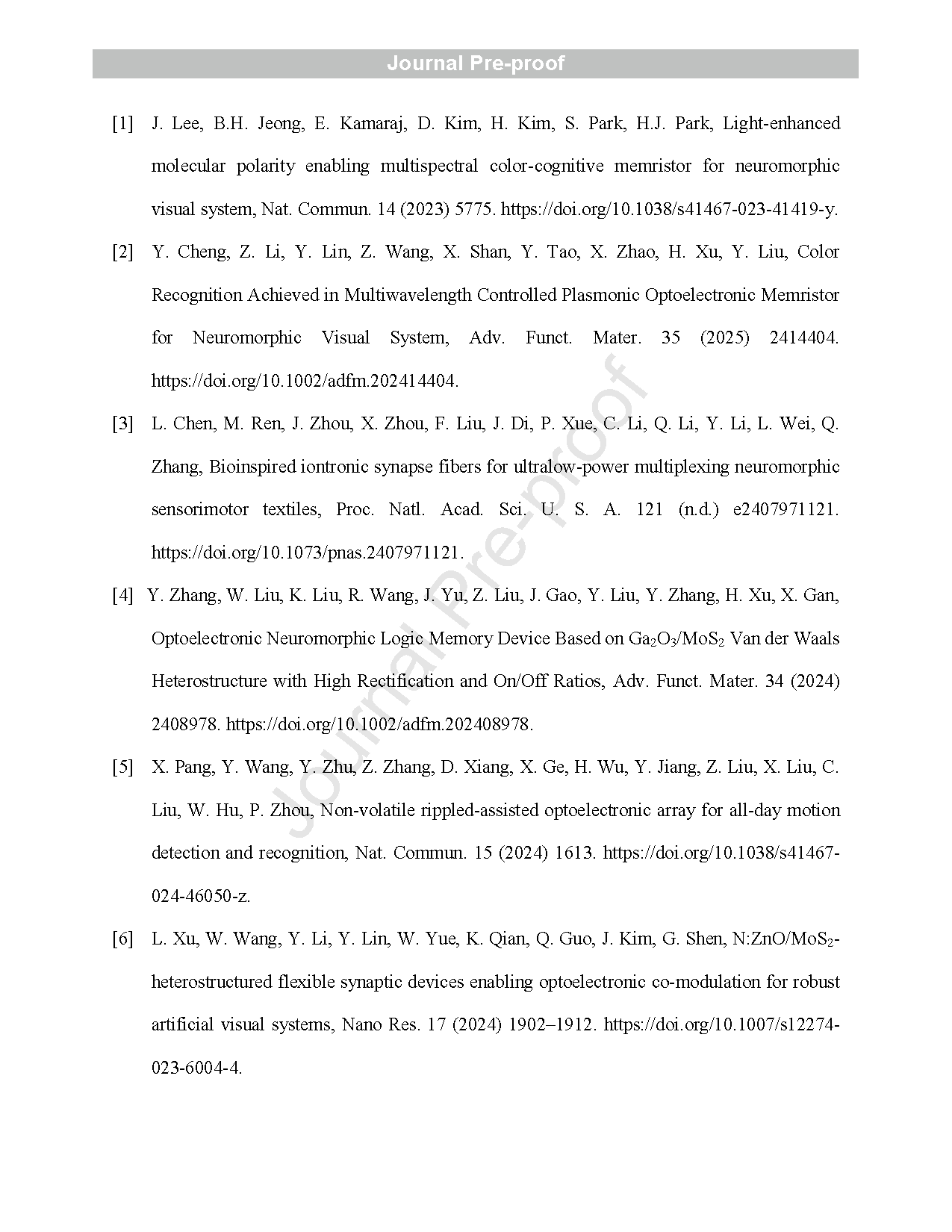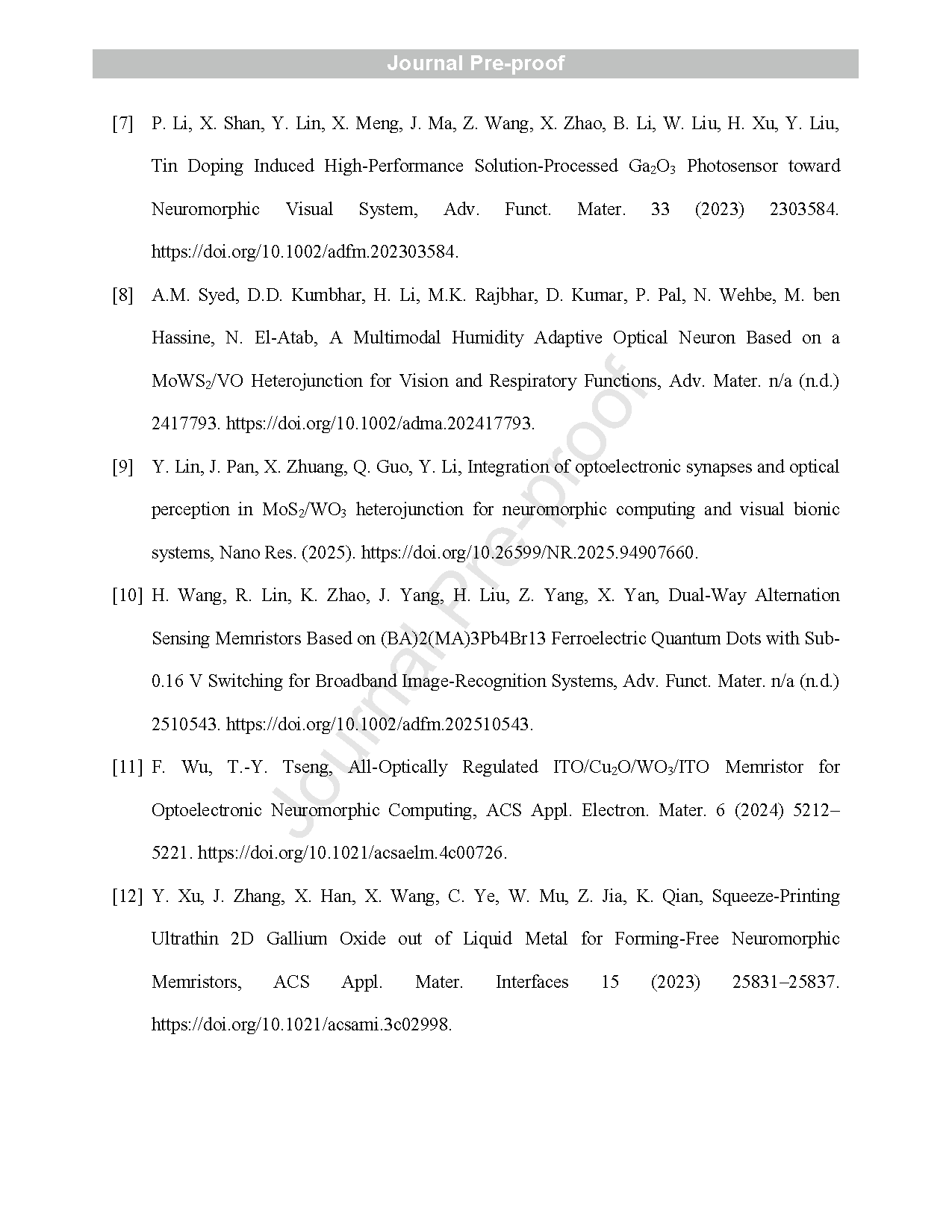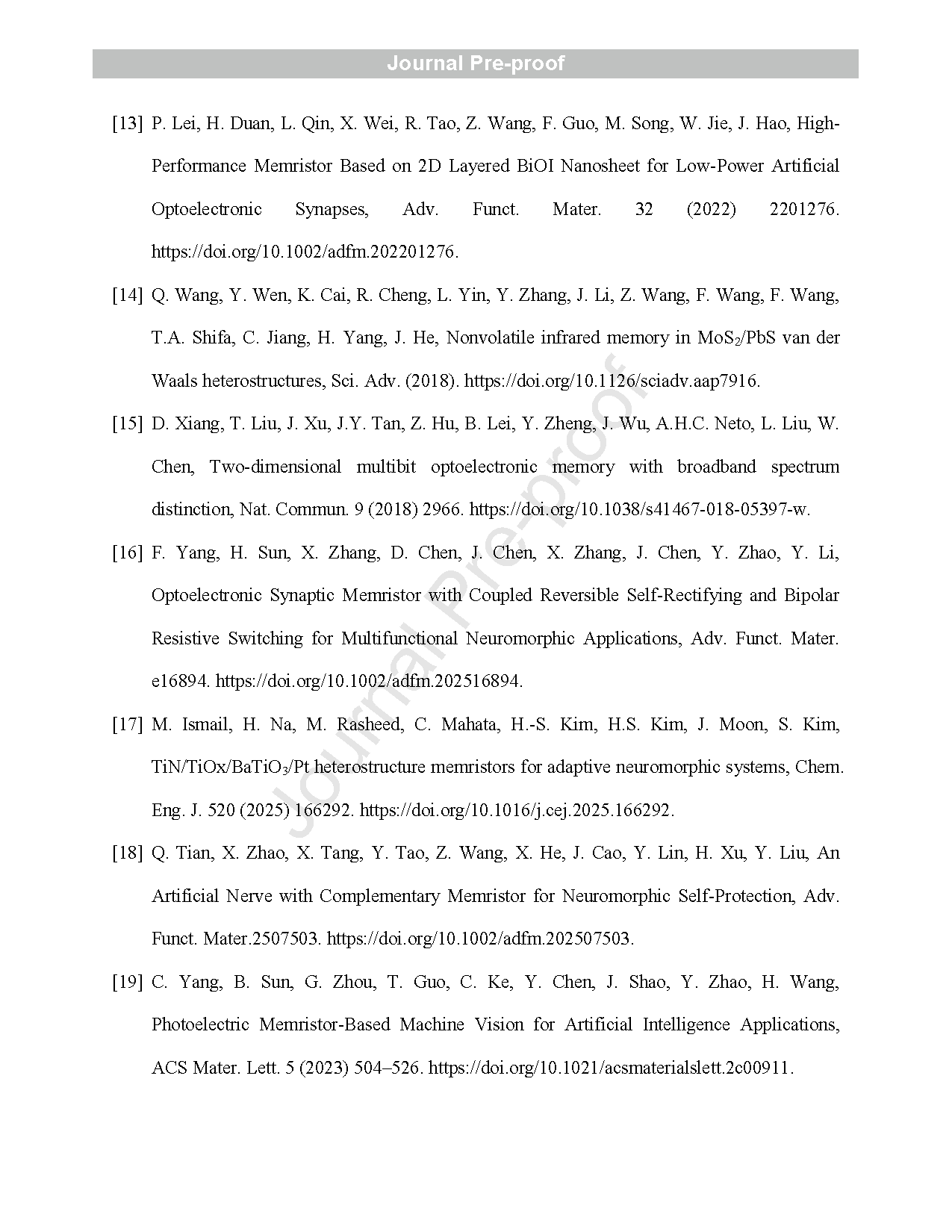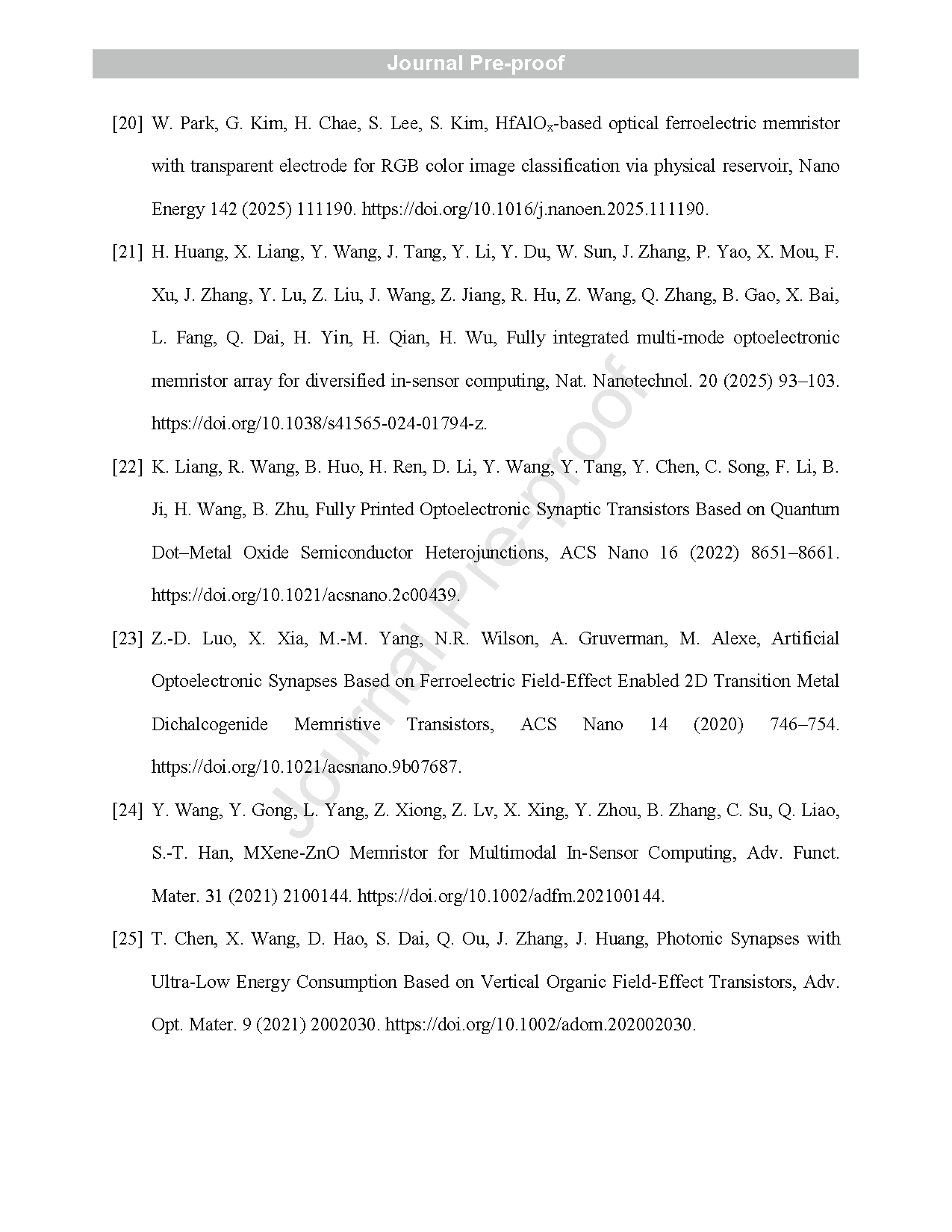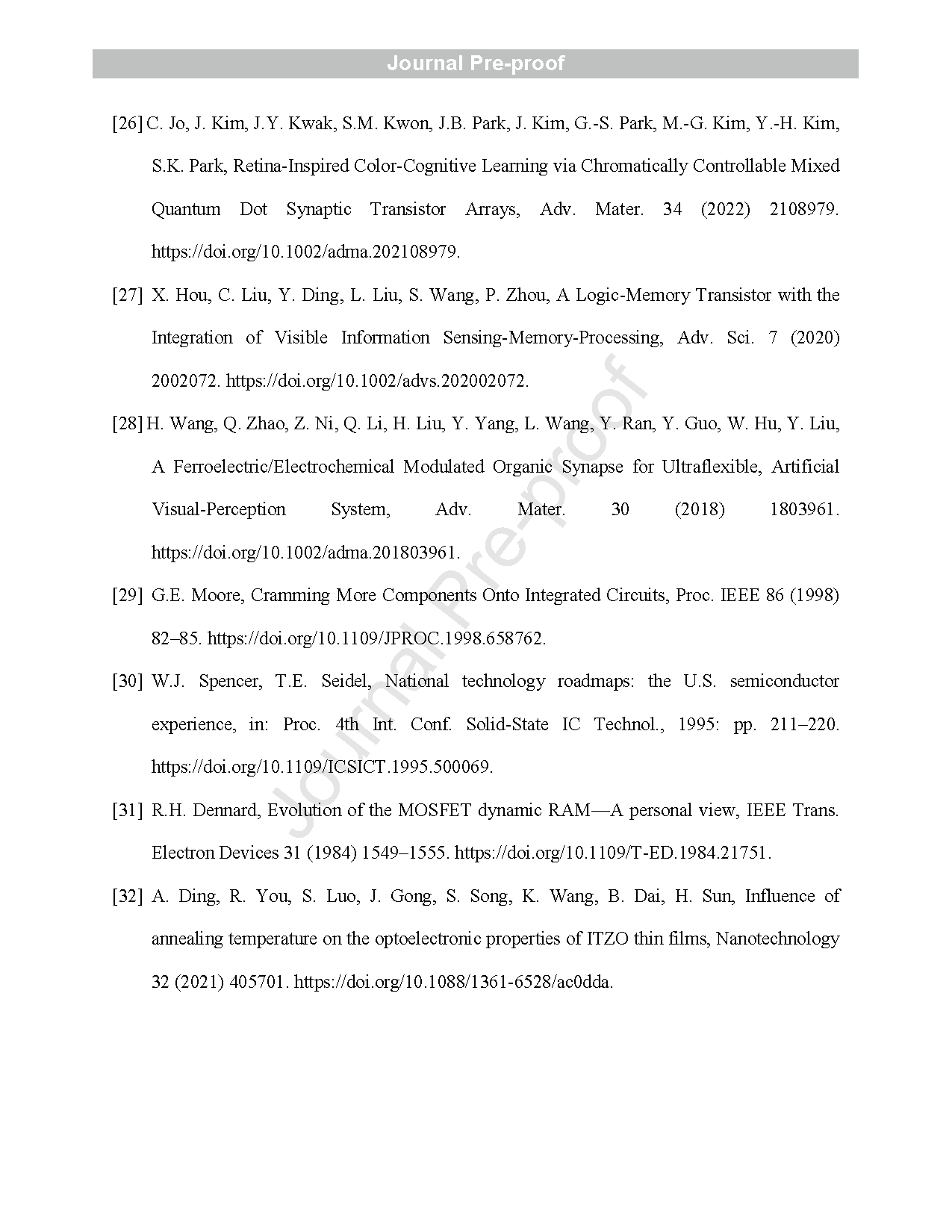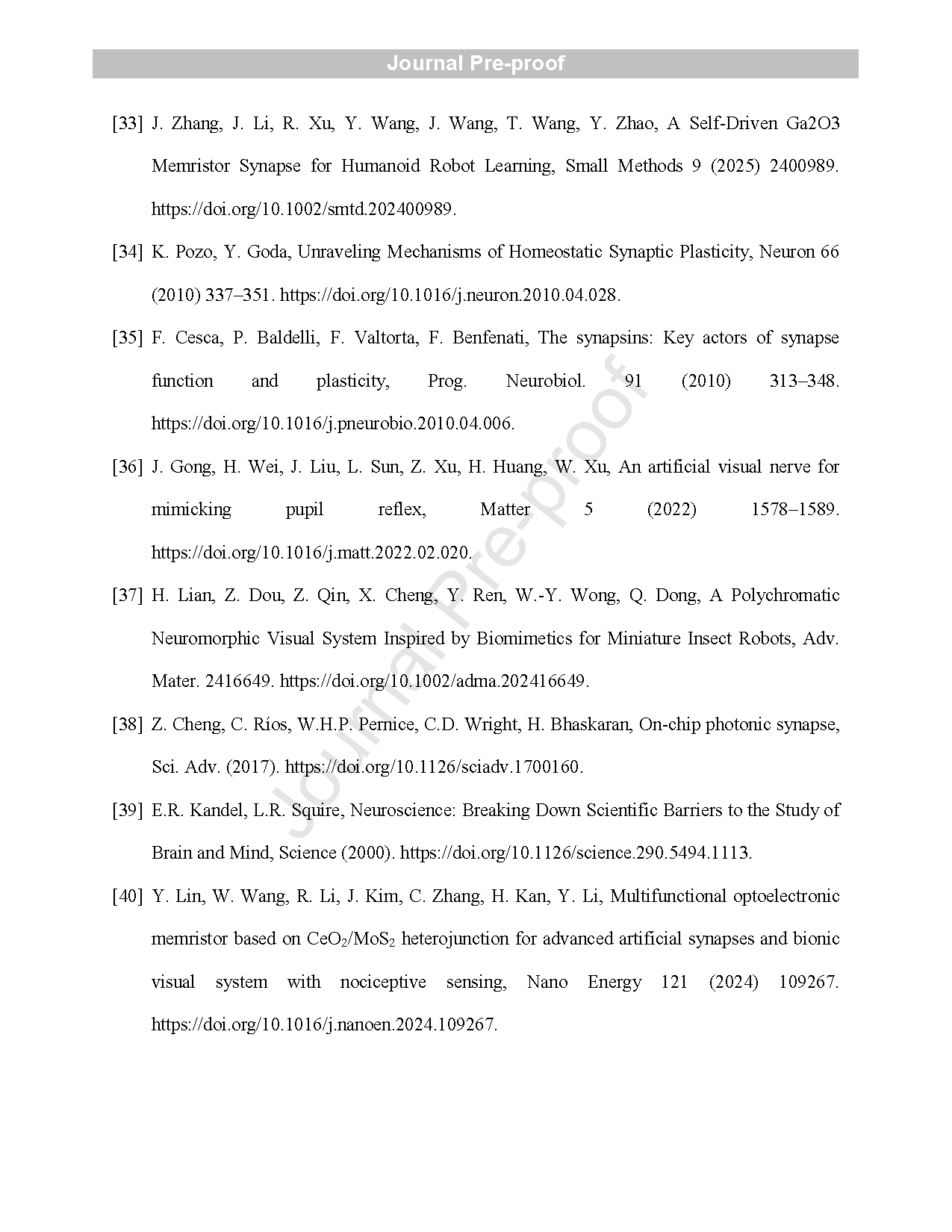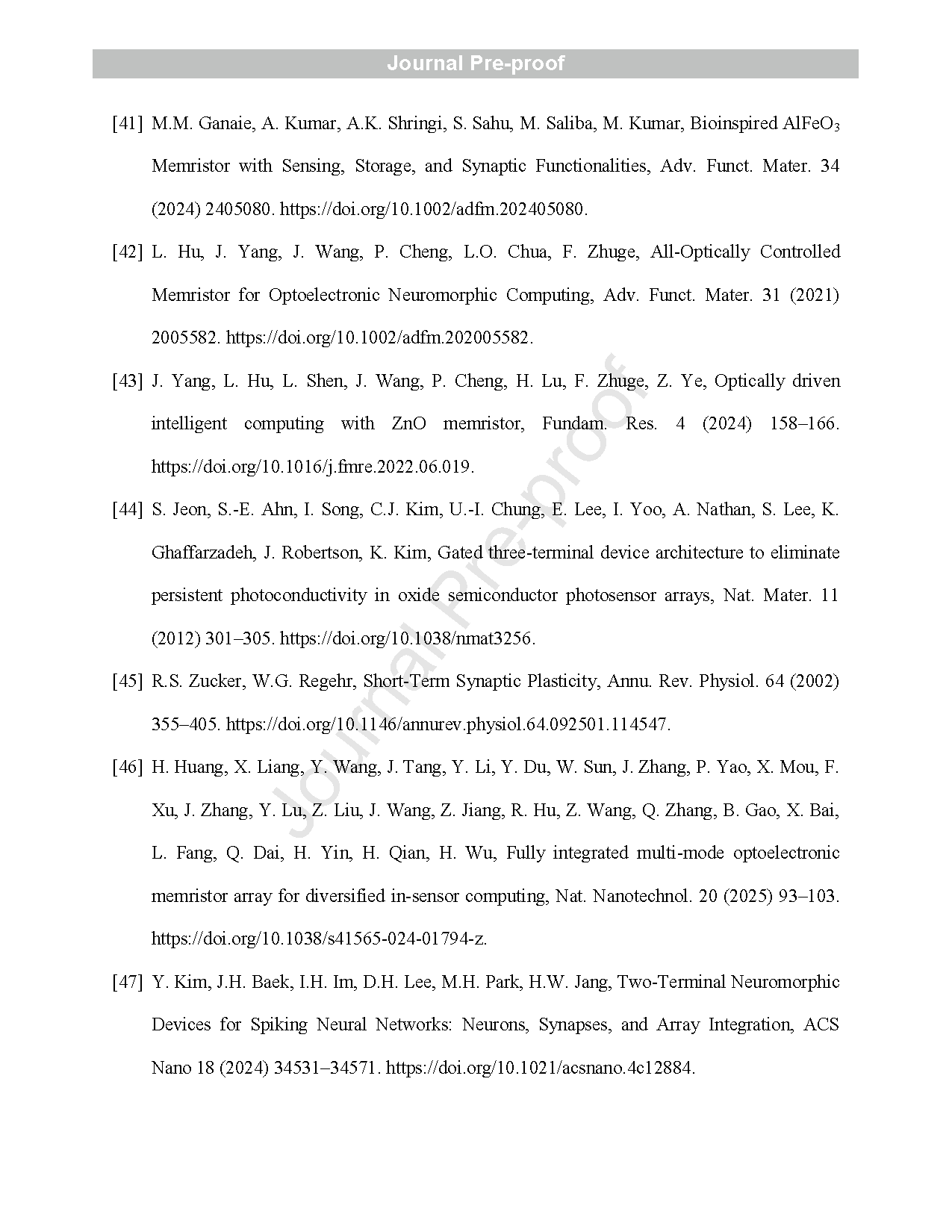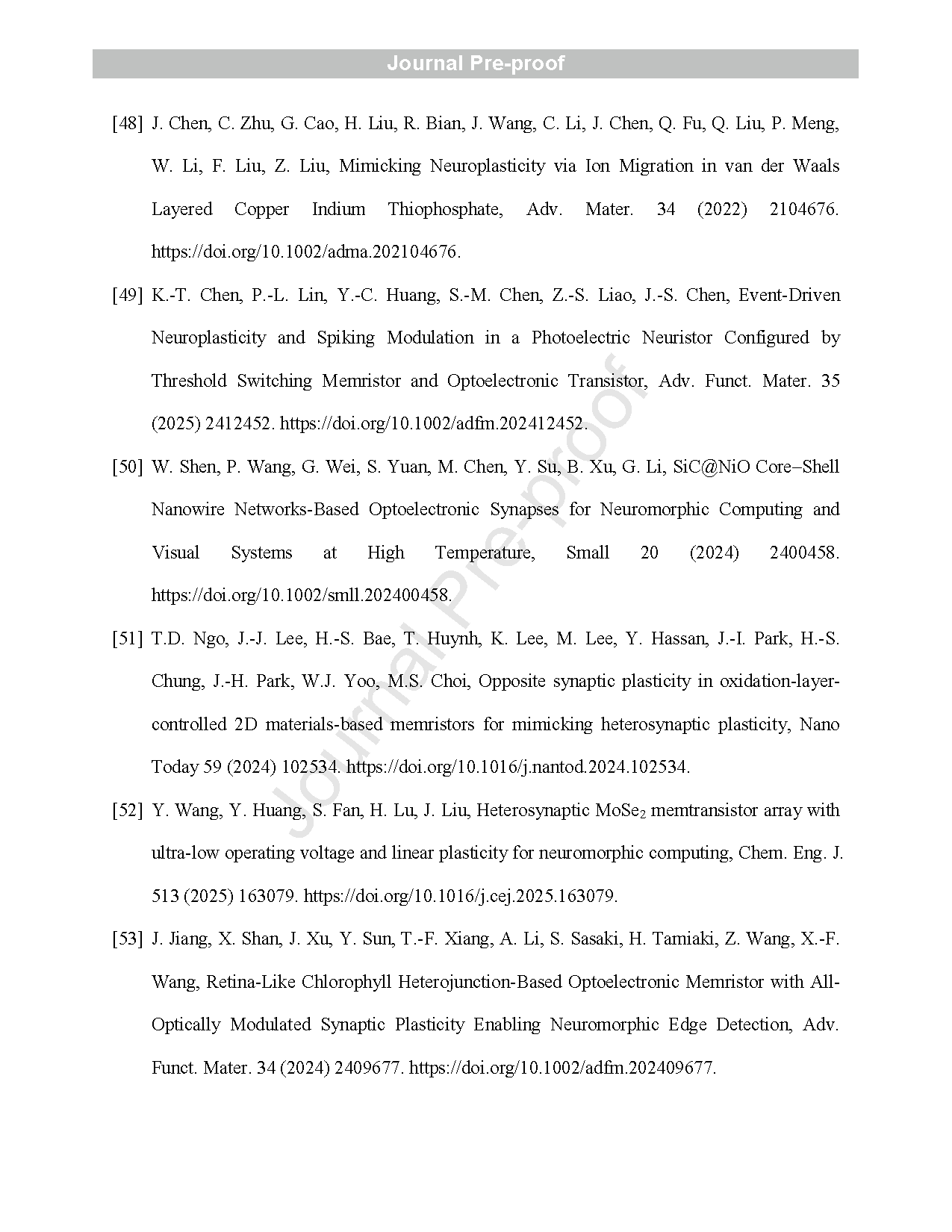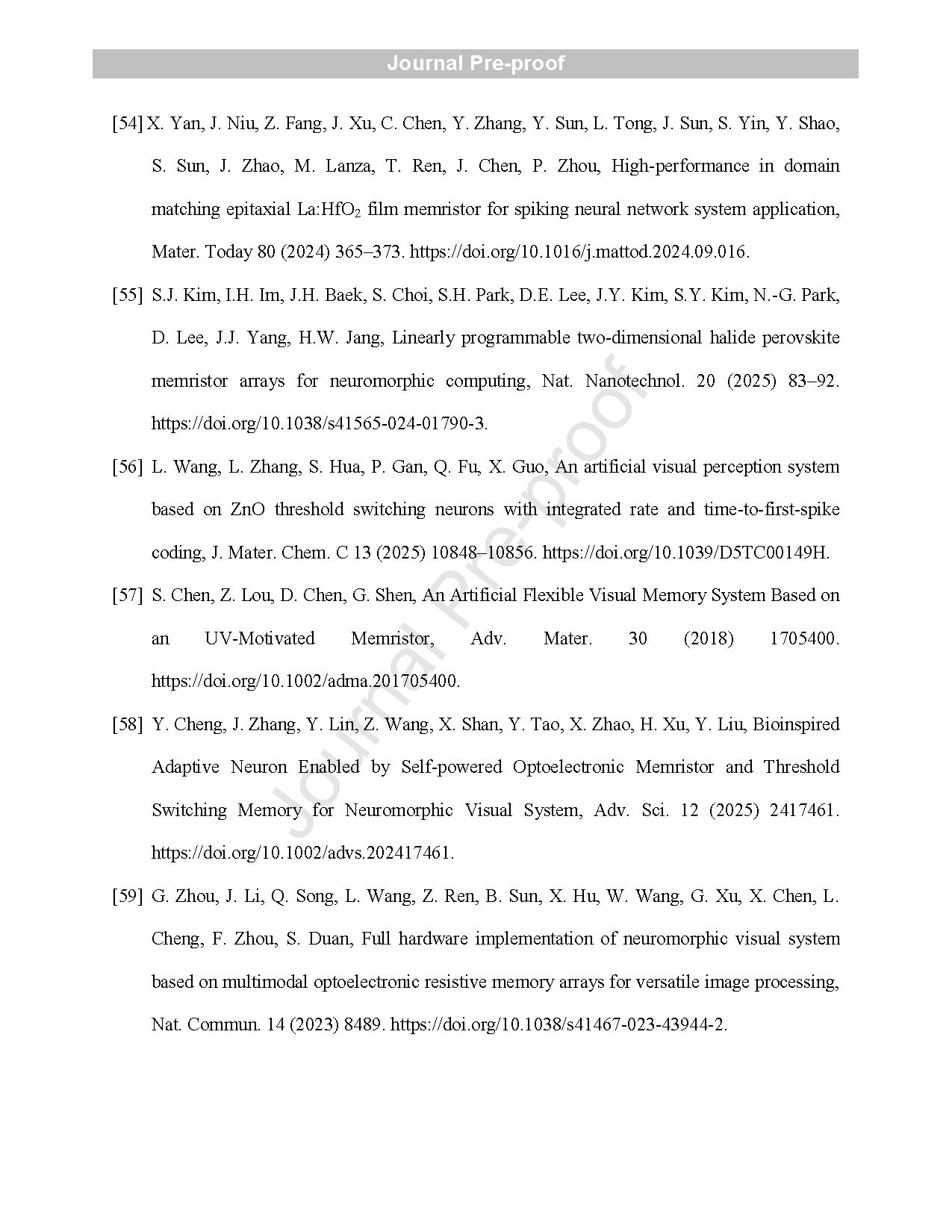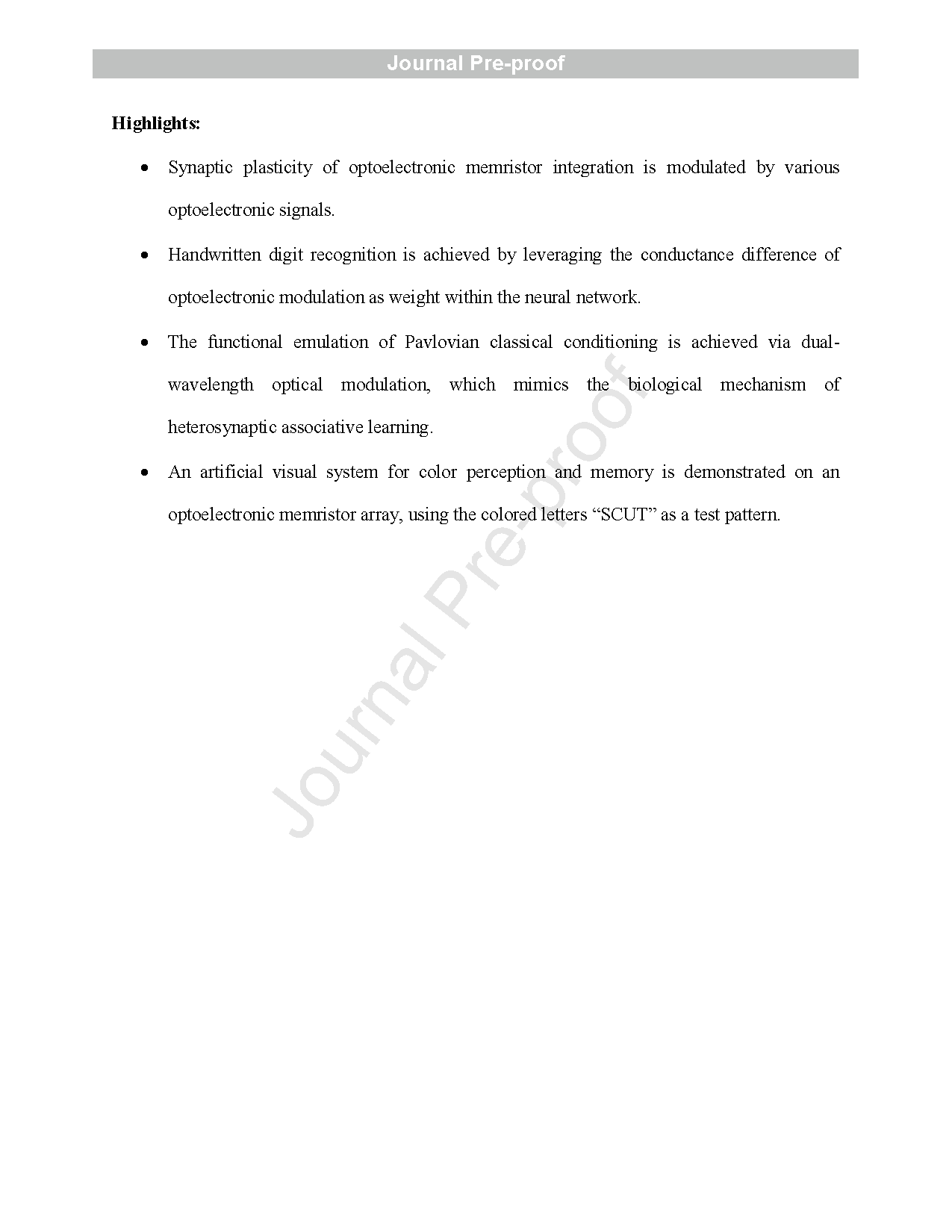

【Domestic Papers】ITZO/Ga₂O₃ heterostructure memristor with integrated optoelectronic synaptic function for neuromorphic vision applications
日期:2025-11-05阅读:186
Researchers from the South China University of Technology have published a dissertation titled "ITZO/Ga2O3 heterostructure memristor with integrated optoelectronic synaptic function for neuromorphic vision applications" in Chemical Engineering Journal.
Project Support
This work was supported by the National Key Research and Development Program of China under Grant 2024YFE0100400, the National Natural Science Foundation of China under Grants (62311540155), the Natural Science Foundation of Guangdong Province (2024A1515011719), and the National Naural Science Foundation of China (61871195).
Background
Recent advances in neuromorphic vision, inspired by biological visual systems, aim to integrate perception, memory, and computation into compact, energy-efficient devices. Memristors have emerged as promising candidates due to their ability to emulate synaptic plasticity, CMOS compatibility, and fast switching, but traditional electrically stimulated devices face limitations for vision-related tasks requiring optoelectronic synergy. Optoelectronic memristors, which combine light sensing with memory and computation, offer a pathway for artificial visual systems capable of color recognition, learning, and motion perception. Despite progress in multispectral and synaptic device design, challenges remain in achieving high performance, functional integration, and scalability. This motivates the development of single-device optoelectronic memristors that can simultaneously perform synaptic modulation, multicolor perception, and neuromorphic computation, providing a foundation for bioinspired, integrated vision systems.
Abstract
Neuromorphic visual systems integrate perception, memory, and processing functions, enabling brain-inspired perception of visual information through optoelectronic memristors as core components. These systems offer a promising pathway toward compact and intelligent visual sensors. However, current optoelectronic memristors still face significant challenges in terms of broadband spectral response, synergistic optoelectronic modulation, and multifunctional integration. These limitations critically hinder their practical deployment in complex visual tasks and impede large-scale system-level integration. This work presents an optoelectronic memristor constructed with an Ag/indium tin zinc oxide (ITZO) /Ga2O3/indium tin oxide (ITO) heterostructure. Benefiting from its pronounced photoconductivity and effective interfacial modulation, the device demonstrates reliable synaptic plasticity and enables optically driven heterosynaptic modulation. Leveraging optoelectronically tunable conductance states as synaptic weights, the memristor achieves a high recognition accuracy of 97.13 % on the MNIST dataset using a convolutional neural network. Furthermore, a 3 × 5 device array exhibits integrated color perception and memory functions under multicolor illumination (275, 365, 470, and 550 nm), highlighting its promise for future neuromorphic vision applications. The development of such devices establishes a robust physical basis for intelligent visual systems that seamlessly integrate perception, cognition, and memory, and opens new pathways toward scalable neuromorphic computing architectures.
Highlights
•Synaptic plasticity of optoelectronic memristor integration is modulated by various optoelectronic signals.
•Handwritten digit recognition is achieved by leveraging the conductance difference of optoelectronic modulation as weight within the neural network.
•The functional emulation of Pavlovian classical conditioning is achieved via dual-wavelength optical modulation, which mimics the biological mechanism of heterosynaptic associative learning.
•An artificial visual system for color perception and memory is demonstrated on an optoelectronic memristor array, using the colored letters “SCUT” as a test pattern.
Conclusion
In summary, we have developed an optoelectronic memristor constructed from an Ag/ITZO/Ga₂O₃/ITO structure, which realizes the integrated functional integration of optoelectronic synaptic behavior, neuromorphic computing, and multi-color image recognition and memory. The device exhibits consistent synaptic characteristics, including PPF, LTP, LTD, STM, LTM, and learning–forgetting–relearning cycles, validating its capability as an artificial synapse.
Moreover, heterosynaptic modulation based on light-modulated Pavlovian classical conditioning demonstrates the device’s ability to process complex input patterns. By employing the conductance states modulated through optoelectronic co-stimulation as synaptic weights in a CNN, the device demonstrates excellent neuromorphic computing performance, achieving a high pattern recognition accuracy of 97.13%. In a 3×5 optoelectronic memristor array configuration, it further realizes distinguishable responses to multiple wavelengths and enables integrated multicolor image perception and memory. These results underscore the device’s potential as a highly promising candidate for future neuromorphic vision systems.
In conclusion, the successful integration of complex associative learning, brain-inspired computing, and coupled perception–memory functionalities within a single optoelectronic memristor platform demonstrates significant promise for the advancement of next-generation intelligent electronic devices. This work provides a foundational step toward the realization of perceptual computing systems that can emulate biological sensory-processing mechanisms with high efficiency, adaptability, and functional density. Although the ITZO/Ga₂O₃ optoelectronic memristor exhibits excellent photoresponse and stable synaptic plasticity, some limitations remain, such as interfacial defects and restricted spectral sensitivity. Future work will focus on optimizing material composition and interface engineering to improve uniformity, extend the response range, and enable large-scale integration for advanced neuromorphic vision systems.
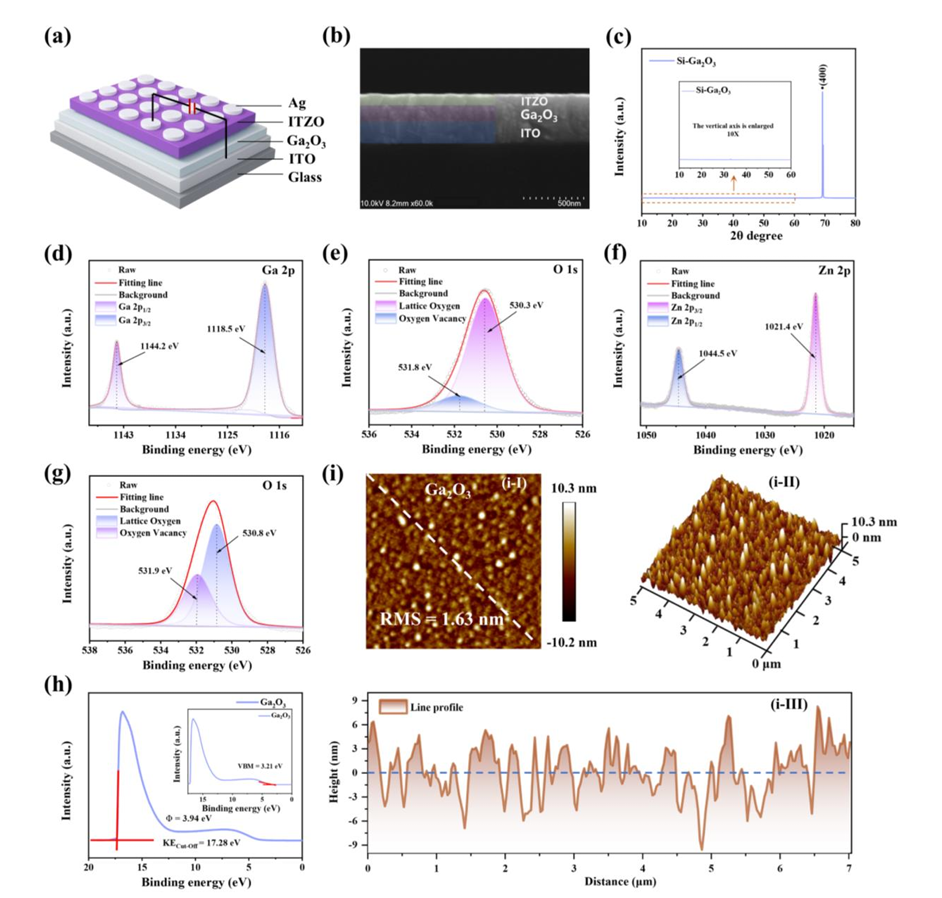
Fig. 1. Structural analysis of the ITO/Ga2O3/ITZO/Ag heterojunction device. (a) Schematic illustration of the device structure featuring the Ga2O3/ITZO heterojunction. (b) Cross-sectional SEM image of the ITO/Ga2O3/ITZO multilayer. (c) XRD pattern of the Ga2O3 thin film. (d, e) XPS analysis of the Ga2O3 film: (d) Ga 2p core-level spectrum and (e) O 1s peak. (f, g) XPS spectra of the ITZO film: (f) Zn 2p core level and (g) O 1s spectrum. (h) UPS spectrum of the Ga2O3 layer. (i) AFM characterization of the Ga2O3 film. (i-I) Two-dimensional and (i-II) three Journal Pre-proof dimensional AFM images of the Ga2O3 surface over a 5 × 5 µm2 area. (i-III) Cross-sectional height profile extracted along the white dashed line shown in (i-I).
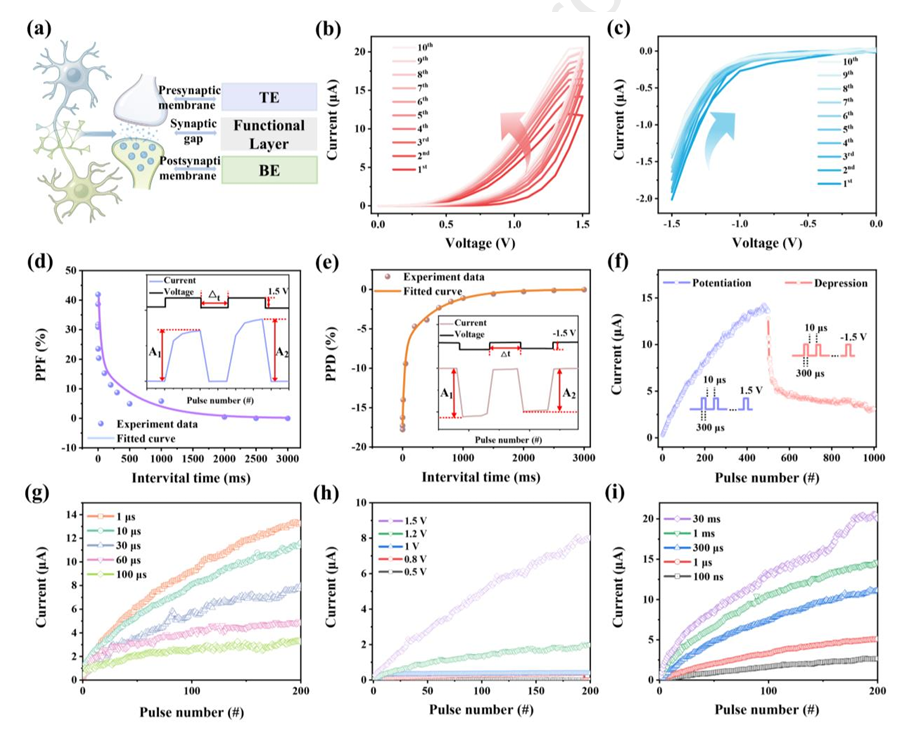
Fig. 2. Electrically driven artificial synaptic functionalities. (a) Conceptual comparison between biological synapses and their artificial counterparts. (b, c) I–V characteristics of the device over 10 consecutive cycles under positive and negative voltage sweeps, respectively. (d, e) PPF and PPD characteristics. The insets display representative responses under pulsed input. (f) Emulation of LTSP through potentiation and depression induced by +1.5 V/–1.5 V, respectively. (g-i) Modulation of device current as a function of pulse interval, amplitude, and width.
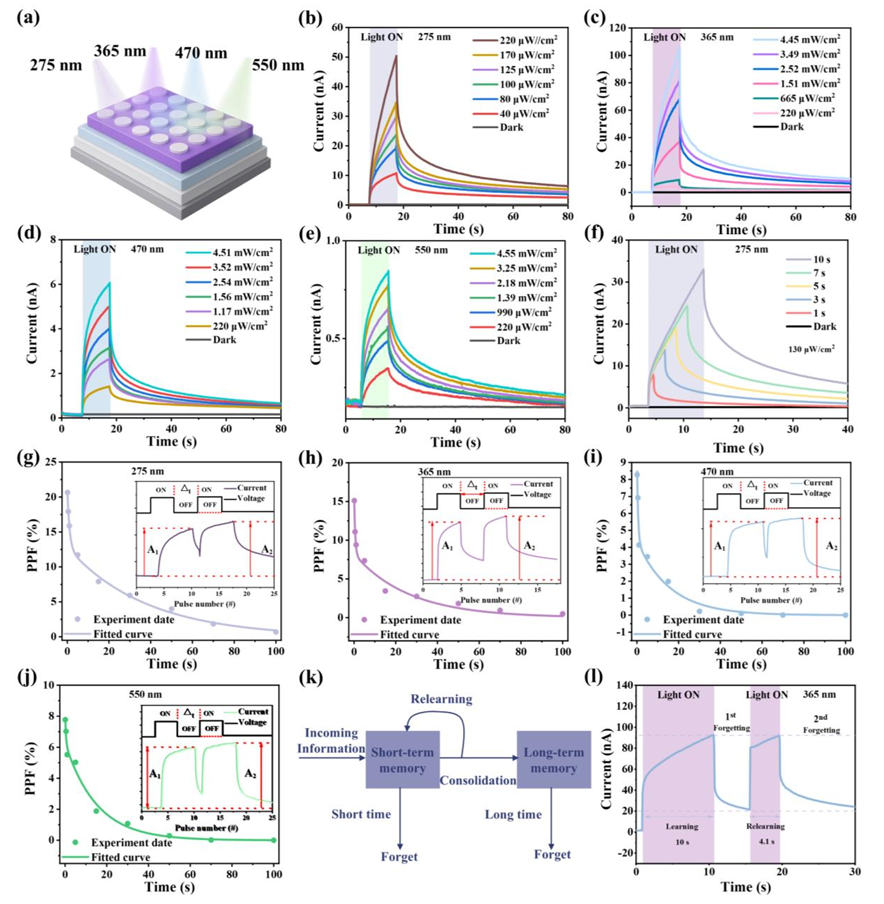
Fig. 3. Optoelectronic synaptic properties of the Ga2O3/ITZO heterostructure device. (a) Schematic illustration of the device under illumination at different wavelengths (275, 365, 470, and 550 nm). (b–e) Photocurrent response curves measured under varying light intensities at specific wavelengths: 275 nm, 365 nm, 470 nm, and 550 nm, followed by the corresponding current relaxation after light is switched off. (f) Photocurrent response under different light durations at a constant intensity of 130 μW/cm2. (g–j) PPF index as a function of inter-pulse interval under optical stimulation at different wavelengths: 275 nm, 365 nm, 470 nm, and 550 nm. Insets show schematic representations of current responses triggered by two consecutive light pulses. (k) Conceptual illustration of the “learning–forgetting–relearning” process under optical stimuli. (l) Experimental demonstration of synaptic plasticity exhibiting sequential learning, forgetting, and relearning processes.
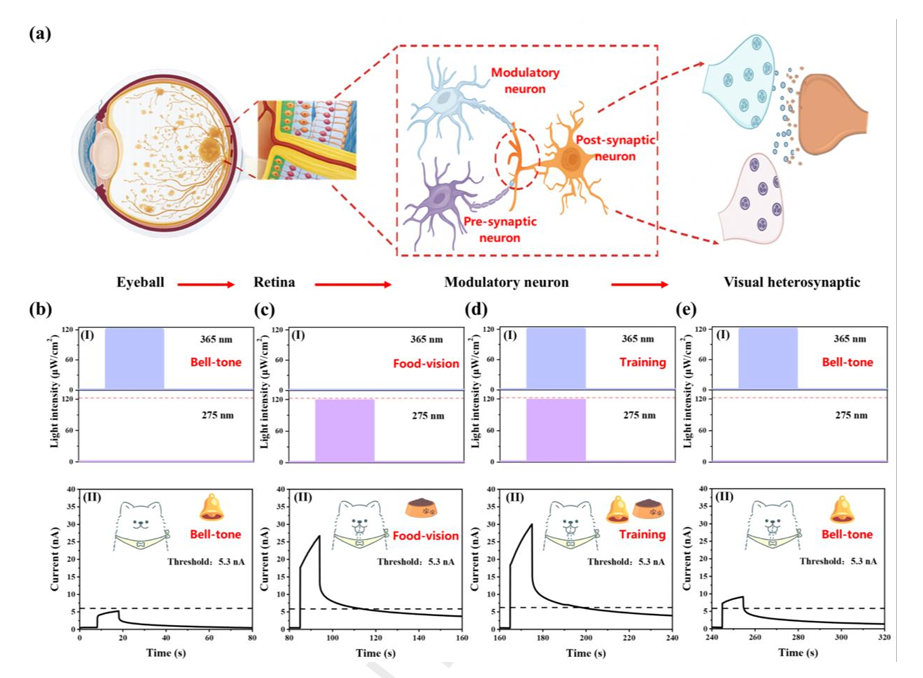
Fig. 4. (a) Schematic illustration of a visual heterosynaptic modulation and its functional correspondence with biological systems. (b) The schematic illustrates the 365 nm optical pulse, acting as a neutral stimulus (NS, bell), elicits only a sub-threshold current, analogous to no salivation response. (c) The schematic illustrates the 275 nm optical pulse, acting as a unconditioned stimulus (US, food), elicits a supra-threshold current, analogous to a salivation response. (d) During the training phase, the combined application of 275 nm and 365 nm optical pulses demonstrates simultaneous NS+US stimulation, where the concurrent presentation of both stimuli induces conditioned salivation. (e) The bell elicits a salivation response.
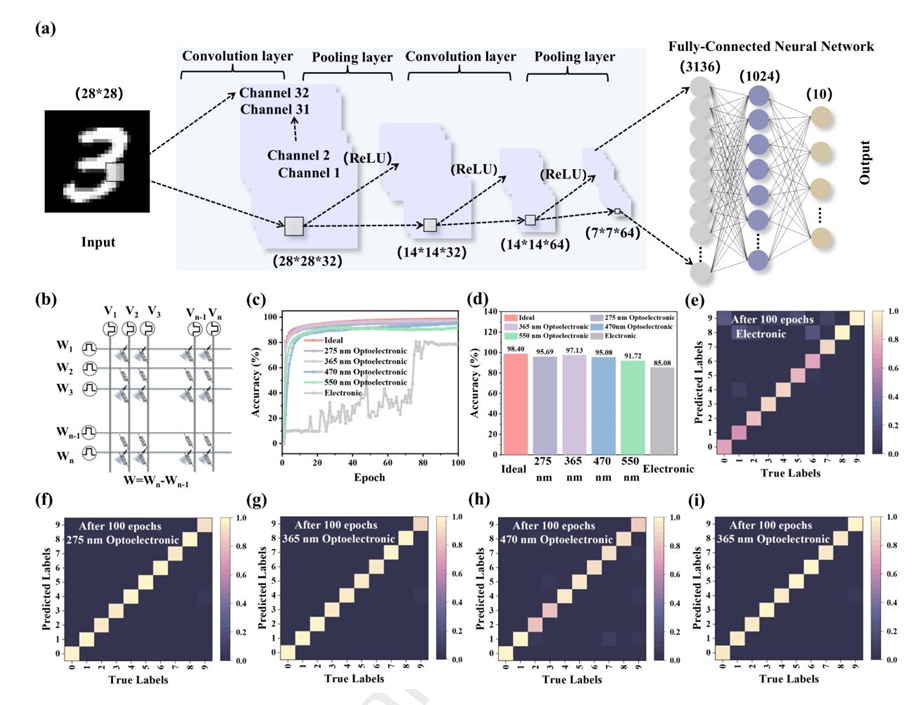
Fig. 5. Application of optoelectronic memristors in handwritten digit recognition. (a) CNN-based recognition flowchart. (b) Optoelectronic co-modulation array. (c) Recognition accuracy versus training iterations under various modulation schemes. (d) After 100 epochs, a comparison of final recognition accuracies across six training methods. (e–i) Confusion matrices obtained under different modulation conditions: electrical-only, and optoelectronic co-modulation with illumination at 275 nm, 365 nm, 470 nm, and 550 nm.
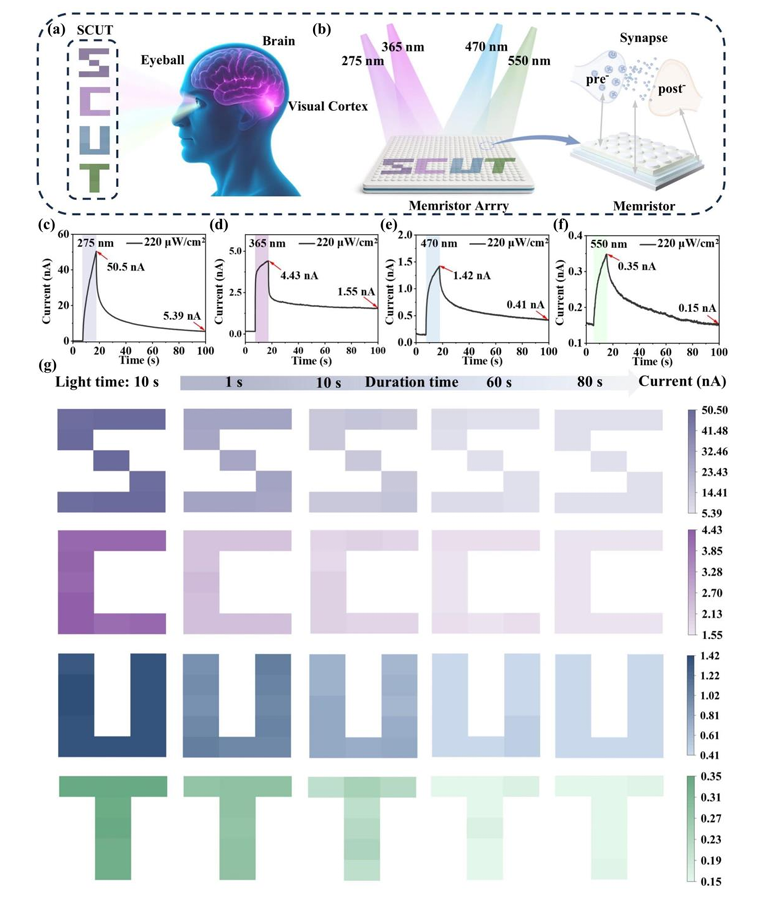
Fig. 6. Artificial visual perception and memory functionalities. (a) Schematic illustration of the artificial visual system. (b) Structural configuration of the optoelectronic memristor array, with an inset illustrating a single synaptic unit. (c–f) Photoresponses are measured after 10 s of illumination at four wavelengths: 275 nm, 365 nm, 470 nm, and 550 nm. (g) The 3×5 optoelectronic array exhibits persistent visual memory performance, as evidenced by its retention of letter patterns “S”, “C”, “U”, and “T” under four different wavelengths, all at a constant intensity of 220 μW/cm2.
DOI:
doi.org/10.1016/j.cej.2025.169684
